Embroidering the Life of Thomas Becket during the Middle Ages: Cult and Devotion in Liturgical Vestments
Abstract
1. Introduction
2. Mitres
3. The Embroidered Panels of the Abegg-Stiftung
4. Embroidered Vestments
4.1. Maniples
4.2. Fragments of Orphrey
4.3. Copes
4.3.1. The Anagni Cope
4.3.2. The St John Lateran Cope
4.3.3. The Bologna Cope
4.3.4. The Hildesheim Cope
4.3.5. The Toledo Cope
4.3.6. The Butler-Bowdon Cope
4.3.7. The Vic Cope
5. A Pall Cloth
6. Conclusions
Funding
Institutional Review Board Statement
Informed Consent Statement
Data Availability Statement
Conflicts of Interest
| 1 | On the life of the saint and the diffusion of his cult, cf. (Barlow 1986; Duggan 2007, 2012; Webster and Gelin 2016; Slocum 2018; Jenkins 2019; Beer 2021). |
| 2 | This article does not consider technical questions on textiles or embroidery, which the author does not specialise in. |
| 3 | The Opus Anglicanum (Latin for English work) is fine needlework of medieval England mostly for liturgical use on vestments (such as copes, orphreys, mitres, chasubles, etc.), altar frontals, palls, hangings, etc. Famous all across Europe since the 12th century, these expensive embroidery pieces were usually made, using silk and gold or silver threads on linen grounds, or later on luxurious velvet. |
| 4 | In some cases, they may have been hidden by families of English Catholics: Wooley (1985, p. 265). |
| 5 | There are several studies on the iconography of Thomas Becket. The first being by Tancred Borenius (Borenius 1932). For more recent analyses, cf. (Nilgen 1996; Gameson 2002; Little 2002; Nickson 2020). |
| 6 | Conversely, our study does not look at the garments worn by, or which came into contact, with Thomas Becket. For more information on the subject, cf. (Mercier 2003; Coatsworth 2012; Shalem 2017). |
| 7 | The surviving corpus is probably larger than detailed in this article. Some full-length representations of the bishop lack an inscription or distinctive symbol, rendering it impossible to accurately identify the figure. |
| 8 | Inv. N°TO27, collection Fondation Roi Baudouin (18.8 × 28 cm). (Christie 1938, p. 60, cat. 20, pl. XIX; Blöcher 2012, pp. 283–84, cat 59). |
| 9 | Inv. N°T.17. (17.3 × 28 cm), cf. (Christie 1938, pp. 60–61, cat. 21, pl. XIV; Durian-Ress 1986; Blöcher 2012, pp. 282–83, cat. 58). |
| 10 | Inv. N°. B 561. (21.5 × 28.5 cm), cf. (Christie 1938, pp. 61–62, cat. n°22, pl. XV; Blöcher 2012, pp. 334–35, cat. 84; Beaulieu and Baylé 1973; Brel-Bordaz 1982). One of the lappets of this mitre now belongs to the collection of the Victoria and Albert Museum in London: Browne et al. (2016, pp. 124–25). |
| 11 | Inv. N°12/00202834, scheda N° 22 (22 × 20 cm), cf. (Blöcher 2012, pp. 183–84, cat. 5). |
| 12 | For an attempt, cf. (Blöcher 2012, p. 90). |
| 13 | St Nicholas is linked to Becket in sources as early as the end of the 12th century. During a storm at sea, which took place during the Third Crusade (1190), Thomas, accompanied by the St Nicholas and by Edmund the Martyr, appeared to the English crusaders three times: Roger of Howden, Gesta regis Henrici secundi (wrongly attributed to Benedict of Peterborough), ed. W. Stubbs, 2 vols (Rolls Series, XLIX, 1867), II, 116; Chronica magistri Rogeri de Houedene, ed. W. Stubbs, 4 vols (Rolls Series, LI, 1868–71), III, 42–43, cited in Duggan, p. 6. On the relationship between the cults of St Nicholas and Thomas Becket, see also (Cavero 2012), and on the martyrdom iconography of medieval mitres, see (Vogt 2007). |
| 14 | It should be noted that the stained glass dedicated to Thomas Becket in Chartres Cathedral is associated in the same chapel (Chapel of the Confessors, in the south of the ambulatory) with a stained-glass piece dedicated to St Nicholas, among others. This is also the case in the lower church at the Abbey of Sta Scholastica, in Subiaco, where the paintings link St Stephen with St Nicholas and Thomas Becket (13th century): Cerone (2021). About the visual responses to the sainthood of Thomas Becket in Italy, see (Cipollaro and Decker 2013). |
| 15 | The Braga mitre (cathedral museum, Portugal), for example, dating back to the beginning of the 13th century (which brings together the martyrdoms of Stephen and Lawrence) was found in a tomb belonging to a bishop from the middle of the 14th century: (Vogt 2002; Vogt 2010, pp. 119–22; Blöcher 2012, pp. 207–9, cat. 17). |
| 16 | The maniple is a ‘liturgical symbol for the bishop, priest, and deacon (eighth century), and later for the sub-deacon serving at the altar (from the ninth century). It resembles a strip of material, generally matching the colour of the chasuble. It derives from an item of Roman clothing used to wipe the face, and which was worn less out of utility and more for its ornamental character. When the stole was no longer used as a shroud, the maniple took its place. It, therefore, became an ecclesiastical symbol towards the end of the sixth century, but did not become fully liturgical until the ninth century. Up to the 11th century, it was held in the left hand. Nowadays, it is worn on the left forearm. From the 12th century, the ends of the garment were extended until, in the 16th century, they became spatula-like in shape. The maniple is a symbol of good deeds, vigilance, and also penance’; cf. (Bavoux 2012, p. 842). |
| 17 | Inv. N°TO29, collection Fondation Roi Baudouin (119 × 8 cm). The patron of the textile piece was probably Jacques de Vitry. |
| 18 | Milagros Guardia identified the two figures in the upper area of the paintings as Thomas Becket and St Stephen (Guardia 1998, p. 54) |
| 19 | Inv. T.5.-1988 (33 × 21 cm) and T.5A-1988 (29 × 22.5 cm), cf. (Kurth 1935; Wooley 1985; Owen Crocker et al. 2012, pp. 64–68; Browne et al. 2016, pp. 245–46). |
| 20 | Like that which is conserved at the Victoria and Albert Museum in London (Inv N°935–1901) and which dates to the first quarter of the 14th century, in which the saint, unlike here, is shown full-length; cf. https://collections.vam.ac.uk/item/O361711/chasuble-unknown/ (accessed on 13 January 2022). |
| 21 | The cope derives from civilian clothing, dating back to antiquity, and was conceived as protection against bad weather, especially rain; the raincoat, a round and relatively large coat, also has a hood. In the Middle Ages, ‘its benediction was not obligatory. This exception is perhaps down to the specific history of this ornament, which was originally used for processions, and therefore outside the church. It was perhaps not strictly a sacerdotal vestment as it was only worn by the officiating priest or bishop during liturgical activities where consecration did not take place’; cf. (Bavoux 2012, p. 129). |
| 22 | Inv. N°12/00202817, scheda N°5 (140 × 325 cm), cf. (Elster 2018, pp. 321–35). |
| 23 | 158 × 336 cm, cf. (Christie 1938, pp. 149–52, cat. 78; King 1963, pp. 40–41; Linnell 1995, pp. 183–223). |
| 24 | Only three feature the Childhood of Christ: the Annunciation, the Nativity, and the Adoration of the Magi. |
| 25 | Inv. N°2040 (149 × 326 cm). The bibliography of this cope is extensive; therefore, we refer to the most recent references: (Bussolati 1993; Owen Crocker et al. 2012, pp. 82–83; Gardner 2016, pp. 213–15; Browne et al. 2016, pp. 176–79). A monograph is currently underway, under the direction of the Musei Civici d’arte Antica di Bologna and Michael A. Michael (2022). See references below. |
| 26 | On the ritual power of vestments within medieval liturgy, see (Glodt 2019). Carne amictus. Vêtir le prêtre, parer l’autel au temps de l’hyperréalisme eucharistique (fin du XIIIe-début du XVIe siècle). (Dressing the priest, adorning the altar in times of Eucharistic hyperrealism) Archivist-palaeographer thesis. Paris, Ecole nationale des Chartres. Thesis statement at http://www.chartes.psl.eu/fr/positions-these/vetir-pretre-parer-autel-au-temps-hyperrealisme-eucharistique-fin-du-xiiie-debut-du (accessed on 20 January 2022). |
| 27 | Inv. N°17–1873 (146 × 298 cm). (Kroos 1970, pp. 142–43, cat. 81; Brandt 1991, pp. 168–69. cat. 61). |
| 28 | On the British Museum website (https://collections.vam.ac.uk/item/O113500/the-hildesheim-cope-cope-unknown/; accessed on 20 January 2022), the scene is identified as the martyrdom of Thomas Becket. Kroos sees the martyrdom of St Matthew (Kroos 1970, pp. 66–69). One of the most recent publications on the vestment does adjudicate in the question of identification, although it suggests that the first hypothesis is interesting. This is how the suffering of Becket is linked with the suffering of another medieval saint who appears on the same register: the Dominican Friar of Verona, Peter Martyr: (Coatsworth and Owen Crocker 2018, pp. 110–13). |
| 29 | Reliquary of the martyrdom of St Thomas of Canterbury (18.7 × 19 cm), originally conserved in Warsaw (Poland), department of National Heritage: (Świeczyński 1988). This is also the case of a reliquary casket attributed to Becket and preserved in St Lawrence Church, at Le Vigean (France). |
| 30 | Perhaps we should consider the scene as an archetypal image of martyrdom linked to the altar? On this topic, cf. (Gauthier 1975). |
| 31 | Museo de Tapices y Textiles de la Catedral (169 × 322 cm), cf. (Thomas 2016, pp. 206–8). |
| 32 | The coat of arms of Cardinal Gil Alvarez Carrillo de Alborñoz would have been embroidered onto the cope, in addition. |
| 33 | Inv. N° T.36–1955 (162 × 287 cm). We cite only the most recent references: (Owen Crocker et al. 2012, pp. 105–6; Browne et al. 2016, pp. 213–16; Coatsworth and Owen Crocker 2018, pp. 114–19). |
| 34 | Inv. N° MEV 1430 (132 × 324 cm). On the work, cf. (Martín Ros 2008; Browne et al. 2016, pp. 233–38). |
| 35 | The reconstruction was carried out on the initiative of Louis de Farcy, from Angers, who was one of the precursors of the study of textiles in the nineteenth century. Published at the end of the century, his work on medieval embroidery remains a source of reference (De Farcy 1890). |
| 36 | (Christie 1938, n° 268; King 1963, p. 58, n° 151). Reproductions can be viewed in the Princeton University Index of Medieval Art: https://ima.princeton.edu/digital-image-collections/view/44428 (accessed on 20 January 2022). About the relationship between the citizens of London and their patron saint, as well as the strong devotion to Becket, see (Jenkins 2020). |
| 37 | We should also add several textual references, which refer to vestments or liturgical pieces on which Thomas Becket appears, to our corpus. Borenius (1932, p. 83) mentions a chasuble from the 15th century which is supposed to be held in the collections of Stonyhurst College (but which I was unable to trace). An inventory from 1388 from the ‘Vestry of Westminster Abbey’ describes an altar frontal which featured the Nativity, the Passion of Thomas Becket and the life of St Edward. It also seems to be mentioned in an inventory from 1540 but the Becketian episode had evidently disappeared at this point (Borenius 1932, p. 88). The inventories of 1245 and 1295 from St Paul’s Cathedral in London list a stole and a maniple which featured, among figures of apostles and prophets, St Thomas and Nicholas. (Lehmann-Brockhaus 1955–1960, Bd 2, p. 137). |
| 38 | One of the possible development axes of our study would be to examine all these vestments in light of liturgical offices for the cult of the saint who was annually commemorated throughout Europe with specific prayers, frequently with special music, another way to keep his memory alive; on this topic, see (Reames 2000; Emery 2020). |
| 39 | Nigel Morgan discusses ‘multipurpose imagery’ with regard to these copes, whose standardised repertoire was popular among the high clergy with whom this luxurious production found great popularity (Morgan 2016, p. 32). |
| 40 | The battle against secular power and the persecutions linked to this combat are a central theme in episcopal hagiography as early as the Gregorian period. We can see that, on some copes, Becket is compared with models of royal saints (e.g., Edward the Confessor and Edmund the Martyr). For more details on the symbolic and political weight of the dedications to Thomas Becket in churches and on altars, as well as representations of the saint in Medieval Italy, cf. (Bottazzi 2011). |
| 41 | On the assimilation of the martyrdom of Becket to Christ’s sacrifice, and the iconographic shift that it results in, cf. (Aurell 2003). |
| 42 | For more information on the creation of a common memoria, which allowed for the construction of a collective self-conscience, we can consult the reference studies (Halbwachs 1925, 1950; Oexle 1992, 1995; Lauwers 2002; Destemberg 2015). |
References
- Ackermann, Hans Christoph. 1994a. Thomas Becket in Riggisberg. In Aachener Kunstblätter des Museumsvereins, Festschrift für Hermann Fillitz zum 70. Geburtstag. Edited by Peter Ludwig. Cologne: M. DuMont Schauberg, vol. 60, pp. 275–84. [Google Scholar]
- Ackermann, Hans Christoph. 1994b. Zwei Opus anglicanum-Stickereien mit Szenen aus dem Leben von Thomas Becket. In Varia 1994, Riggisberger Berichte. Riggisberg: Abegg-Stiftung, pp. 105–35. [Google Scholar]
- Aston, Margaret. 2016. Broken Idols of the English Reformation. Cambridge: Cambridge University Press. [Google Scholar]
- Aurell, Martin. 2003. Le meurtre de Thomas Becket: Les gestes d’un martyre. In Bischofsmord im Mittelalter, Murder of Bishops. Edited by Natalie Fryde and Dirk Reitz. Göttingen: Vandenhoeck and Ruprecht, pp. 187–210. [Google Scholar]
- Barlow, Frank. 1986. Thomas Becket. London: Weidenfeld and Nicolson. [Google Scholar]
- Bavoux, Nadège. 2012. Sacralité, pouvoir, identité. Une histoire du vêtement d’autel (XIIIe—XVIe siècles). Ph.D. thesis, Grenoble University, Grenoble, France. [Google Scholar]
- Beaulieu, Michèle, and Jeanne Baylé. 1973. Mitre épiscopale en France des origines à la fin du XVe siècle. Bulletin archéologique du comité des travaux historiques et scientifiques 9: 41–97. [Google Scholar]
- Beer, Lloyd, ed. 2021. Thomas Becket: Murder and the Making of a Saint. Exhibition. London: The British Museum. [Google Scholar]
- Blöcher, Heidi. 2012. Die Mitren des hohen Mittelalters. Bern: Abegg-Stiftung. [Google Scholar]
- Borenius, Tancred. 1932. St. Thomas Becket in Art. London: Methuen & Co. [Google Scholar]
- Bottazzi, Marialuisa. 2011. Tomaso Becket nella basilica di Aquileia: Celebrazione o propaganda? Mélanges de l’Ecole française de Rome. Les pouvoirs territoriaux en Italie 123–2: 561–76. Available online: https://journals.openedition.org/mefrm/640#ftn109 (accessed on 20 January 2022).
- Bowie, Colette. 2016. Matilda, Duchess of Saxony (1168–1189) and the Cult of Thomas Becket: A Legacy of Appropriation. In The Cult of St Thomas Becket in the Plantagenet World, c. 1170–220. Edited by Paul Webster and Marie-Pierre Gelin. Woodbridge: Boydell & Brewer, pp. 113–32. [Google Scholar]
- Brandt, Michael. 1991. Schatszkammer auf Zeit. Die Sammlungen des Bischofs Eduard Jakob Wedekin, 1769–1870. Hildesheim: Diözesan-Museum, pp. 168–69, cat. 61. [Google Scholar]
- Brel-Bordaz, Odile. 1982. Broderies d’ornements liturgiques XIIIe-XIVe siècles. Paris: Nouvelles Editions latines. [Google Scholar]
- Brisac, Catherine. 1975. Thomas Becket dans le vitrail français. In Thomas Becket. Actes du colloque international de Sédières. Edited by Raymonde Foreville. Paris: Beauchesne, pp. 222–31. [Google Scholar]
- Browne, Clare, Glyn Davies, and Michael A. Michael, eds. 2016. English Medieval Embroidery. Opus Anglicanum. New Haven and London: Yale University Press. [Google Scholar]
- Bussolati, Cristina. 1993. Il piviale di San Domenico: Una proposta di lettura. Arte a Bologna, Bollettino dei Musei Civici d’Arte Antica 3: 93–104. [Google Scholar]
- Calonder, Nikkibarla, and Agnieszka Wos-Jucker. 2008. Conservation of the Cope of Bishop Ramon de Bellera. Quaderns del Museu episcopal de Vic 2: 83–99. [Google Scholar]
- Cavero, Gregoria. 2012. San Nicolás de Bari y Santo Tomás de Canterbury en la religiosidad del siglo XII. In Los fueros de Avilés y su época. Edited by Juan Ignacio Ruiz de la Peña Solar, María Josefa Sanz Fuentes and Miguel Calleja Puerta. Oviedo: Real Instituto de Estudios Asturianos, pp. 281–302. [Google Scholar]
- Cerda, José Manuel. 2016. Leonor Plantagenet and the Cult of Thomas Becket in Castile. In The Cult of St Thomas Becket in the Plantagenet World, c. 1170–220. Edited by Paul Webster and Marie-Pierre Gelin. Woodbridge: Boydell & Brewer, pp. 133–46. [Google Scholar]
- Cerone, Roberta. 2021. The Lunette with St. Thomas Becket at the Sacro Speco in Subiaco: An Unexpected Presence? Arts 10: 58. [Google Scholar] [CrossRef]
- Christie, Archibald. 1926. A Reconstructed Embroidered Cope at Anagni. The Burlington Magazine 48: 65–77. [Google Scholar]
- Christie, Archibald. 1938. English Medieval Embroidery. A Brief Survey of English Embroideries dating from the Beginning of the Tenth Century until the end of the Fourteenth Century. Oxford: Clarendon Press. [Google Scholar]
- Cipollaro, Costanza, and Veronika Decker. 2013. Shaping a Saint’s Identity: The Imagery of Thomas Becket in Medieval Italy. In Medieval Art, Architecture and Archaeology at Canterbury. Edited by Alixe Bovey. Leeds: Maney, pp. 116–38. [Google Scholar]
- Coatsworth, Elizabeth. 2005. Stitches in Time: Establishing a History of Anglo-Saxon Embroidery. Medieval Clothing and Textiles 1: 1–27. [Google Scholar]
- Coatsworth, Elizabeth. 2012. Becket, St Thomas: His Life and Textile Relics. In Encyclopedia of Medieval Dress and Textiles of the Bristish Iles, c. 450–1450. Edited by Gale R. Owen Crocker, Elizabeth Coatsworth and Maria Hayward. Leiden and Boston: Brill, pp. 64–68. [Google Scholar]
- Coatsworth, Elizabeth, and Gale R. Owen Crocker, eds. 2018. Clothing the Past: Surviving Garments from Early Medieval to Early Modern Western Europe. Leiden and Boston: Brill. [Google Scholar]
- Cros-Guttiérez, Almudena. 2008. The Artistic Patronage of Gil de Albornoz (1302–1367), a Cardinal in Context. Ph.D. thesis, University of Warwick, Coventry, UK. [Google Scholar]
- Davies, Glyn. 2016. For whom the Embroiderer toils. The Role of the Commissioner in the Design of some fourteenth-century Opus Anglicanum Embroideries. In The Age of Opus Anglicanum. Edited by Michael A. Michael. London: Harvey Miller, pp. 74–89. [Google Scholar]
- De Farcy, Louis. 1890. La broderie du XIe siècle jusqu’à nos jours. Paris: E. Leroux. [Google Scholar]
- Descatoire, Christine, ed. 2019. L’art en broderie au Moyen Age: Autour des collections du musée de Cluny. Exhibition. Musée national du Moyen Age, 2019–2020. Paris: RMN-Grand-Palais. [Google Scholar]
- Destemberg, Antoine. 2015. L’honneur des universitaires au Moyen Age. Paris: PUF, pp. 185–224. [Google Scholar]
- Duggan, Anne. 2007. Thomas Becket: Friends, Networks, Texts, and Cult. Aldershot: Burlington. [Google Scholar]
- Duggan, Anne. 2012. Religious Networks in Action: The European Expansion of the Cult of St Thomas Becket of Canterbury. In International Religious Networks. Edited by Jeremy Gregory and Hugh McLeod. Woodbridge: Boydell & Brewer, pp. 20–43. [Google Scholar]
- Duggan, Anne. 2020. Becket’s Cap and the Broken Sword. Jacques de Vitry’s English Mitre in the Context. The Cult of St Thomas Becket: Art. Relics and Liturgy in Britain and Europe. Journal of the British Archaeological Association 173: 3–25. [Google Scholar]
- Durian-Ress, Saskia. 1986. Mitra aus Kloster Seligenthal bei Landshut. In Meisterwerke mittelalterliche Textilkunst aus dem Bayerisches Nationalmuseum. München and Zurich: Schnell and Steiner, pp. 20–21. [Google Scholar]
- Elster, Christiane. 2014. Liturgical Textiles as Papal Donations in Late Medieval Italy. In Dressing the Part: Textiles as Propaganda in the Middle Ages. Edited by Kate Dimitrova and Margaret Goehring. Turnhout: Brepols, pp. 65–79. [Google Scholar]
- Elster, Christiane. 2018. Die Textilen Geschenke Papst Bonifaz’VIII. (1294–1303) An die Kathedrale von Anagni. Petersberg: Michael Imhof Verlag. [Google Scholar]
- Emery, Katherine. 2020. Architecture, Space and Memory: Liturgical Representation of Thomas Becket, 1170–1220. The Cult of St Thomas Becket: Art. Relics and Liturgy in Britain and Europe. Journal of the British Archaeological Association 173: 61–77. [Google Scholar] [CrossRef]
- Gameson, Richard. 2002. The early Imagery of Thomas Becket. In Pilgrimage. The English Experience from Becket to Bunyan. Edited by Colin Morris and Peter Roberts. Cambridge: Cambridge University Press, pp. 46–89. [Google Scholar]
- Gardner, Julian. 2016. Papal Exactions. Royal Gifts and fashionable Cardinals. The Curial Clientele for Opus Anglicanum c. 1300–1370. In The Age of Opus Anglicanum. Edited by Michael A. Michael. London: Harvey Miller, pp. 23–35. [Google Scholar]
- Gauthier, Marie-Madeleine. 1975. Le meurtre dans la cathédrale, thème iconographique médiéval. In Thomas Becket. Actes du colloque international de Sédières. Edited by Raymonde Foreville. Paris: Beauchesne, pp. 249–54. [Google Scholar]
- Gazeau, Véronique, Catherine Guyon, and Catherine Vincent, eds. 2015. En Orient et en Occident, le culte de saint Nicolas en Europe (Xe-XXIe siècle). In Actes du colloque de Lunéville et Saint-Nicolas-de-Port. Paris: Cerf. [Google Scholar]
- Geijger, Agnes. 1956. Engelske brodierier av romansk typ. Nordefjeldske Kunstindustriemuseum Arbok 7: 43–69. [Google Scholar]
- Glodt, Julie. 2019. Carne amictus. Vêtir le prêtre, parer l’autel au temps de l’hyperréalisme eucharistique (fin du XIIIe-début du XVIe siècle). Archivist-palaeographer. Master’s thesis, Ecole nationale des Chartes, Paris, France. [Google Scholar]
- Guardia, Milagros. 1998. Sant Tomàs Becket i el programa iconogràfic de les pintures murals de Santa Maria de Terrassa. Locus Amoenus 4: 37–58. [Google Scholar] [CrossRef][Green Version]
- Halbwachs, Maurice. 1925. Les Cadres sociaux de la mémoire. Paris: Félix Alcan. [Google Scholar]
- Halbwachs, Maurice. 1950. La mémoire collective. Paris: PUF. [Google Scholar]
- Harrison Caviness, Madeline. 1977. The Early Stained Glass of Canterbury Cathedral, circa 1175–1220. Princeton: Princeton University Press. [Google Scholar]
- Jenkins, John. 2019. Replication or rivalry? The ‘Becketization’ of pilgrimage in English Cathedrals. Religion 49: 24–47. [Google Scholar] [CrossRef]
- Jenkins, John. 2020. St Thomas Becket and Medieval London. History 105: 652–72. [Google Scholar] [CrossRef]
- Jordan, Alyce. 2009. Rhetoric and Reform: The St Thomas Becket Window of Sens Cathedral. In The Four Modes of Seeing: Approaches to Medieval Imagery in Honor of Madeline Harrison Caviness. Edited by Evelyn Lane, Elizabeth Pastan and Ellen Shortell. Farham: Routledge, pp. 547–65. [Google Scholar]
- Jordan, Alyce. 2016. The Becket Windows at Angers et Coutances. In The Cult of St Thomas Becket in the Plantagenet World, c.1170-c.1220. Edited by Paul Webster and Marie-Pierre Gelin. Woodbridge: The Boydell Press, pp. 171–207. [Google Scholar]
- Joubert, Fabienne, ed. 2006. L’artiste et le clerc: Commandes artistiques des grands ecclésiastiques à la fin du Moyen Âge, XIVe—XVIe siècles. Paris: Presses de l’Université de la Sorbonne. [Google Scholar]
- King, Donald. 1963. Opus Anglicanum: English Medieval Embroidery. London: Arts Council. [Google Scholar]
- Kosztolnyik, Zoltan J. 1980. The Church and Bela III of Hungary (1172–92): The Role of Archbishop Lukacs of Esztergom. Church History 49: 375–86. [Google Scholar] [CrossRef]
- Kroos, Renate. 1970. Niedersächsische Bildstickereien des Mittelalters. Berlin: Deutscher Verlag für Kunstwissenschaft, pp. 142–43, cat. 81. [Google Scholar]
- Kurth, Betty. 1935. Zwei englische Stickerei-Fragmente mit der Legende des H.L. Thomas Becket. Pantheon 15: 161–62. [Google Scholar]
- Lauwers, Michel. 2002. Memoria. À propos d’un objet d’histoire en Allemagne. In Les tendances actuelles de l’histoire du Moyen Age en France et en Allemagne. Edited by Jean-Claude Schmitt and Otto Gerard Oexle. Paris: Publications de la Sorbonne, pp. 105–26. [Google Scholar]
- Lehmann-Brockhaus, Otto. 1955–1960. Lateinische Scriftquellen zur Kunst in England, Wales und Schottland vom Jahre 901 bis zum Jahre 1307. 5 bd. München: Prestel. [Google Scholar]
- Leibacher Ward, Susan. 2007. Saints in Split Stitch: Representations of Saints in Opus Anglicanum Vestments. Medieval Clothing and Textiles 3: 41–54. [Google Scholar]
- Linnell, Christine. 1995. Opus Anglicanum with particular References to Copes as liturgical Show-pieces, ecclesiastical Exemplars and eucharistic Exegetes. Ph.D. thesis, University of St. Andrews, St Andrews, UK. [Google Scholar]
- Little, Charles. 2002. The Road to Glory: New Early Images of Thomas Becket’s Life. In Reading Medieval Images: The Art Historian and the Object. Edited by Elisabeth Sears and Thelma Katrina Thomas. Ann Arbor: University of Michigan, pp. 201–11. [Google Scholar]
- Martín Ros, Rosa M. 2008. Noves aportacions a la iconografia de la capa pluvial del bisbe Ramon de Bellera. Opus anglicanum del s. XIV. Quaderns del Museu Episcopal de Vic 2: 9–81. [Google Scholar]
- Medica, Massimo. 2022. A King’s Gift to a Pope: Benedict XI and the Bologna Cope. In The Bologna Cope: Patronage, History, Iconography, and Conservation. Edited by Michael A. Michael. Turnhout: Brepols, forthcoming. [Google Scholar]
- Mercier, Delphine. 2003. Reliques textiles de saint Thomas Becket conservées en France et en Belgique. Mémoire de DEA. Paris: Université Paris IV Sorbonne. [Google Scholar]
- Michael, Michael A., ed. 2022. The Bologna Cope: Patronage, History, Iconography, and Conservation. Turnhout: Brepols, forthcoming. [Google Scholar]
- Miller, Maureen. 2014. Clothing the Clergy. Virtue and Power in Medieval Europe, c. 800–1200. Ithaca and London: Cornell University Press. [Google Scholar]
- Morgan, Nigel. 2016. Embroidered Textiles in the Service of the Church. In English Medieval Embroidery. Opus Anglicanum. Edited by Clare Browne, Glyn Davies and Michael A. Michael. New Haven and London: Yale University Press, pp. 25–39. [Google Scholar]
- Nickson, Tom. 2020. The Cult of St Thomas Becket: Art. Relics and Liturgy in Britain and Europe. The Cult of St Thomas Becket: Art. Relics and Liturgy in Britain and Europe. Journal of the British Archaeological Association 173: 1–2. [Google Scholar]
- Nilgen, Ursula. 1996. The Manipulated Memory: Thomas Becket in Legend and Art. In Memory and Oblivion. Paper presented at XXIXth International Congress of the History of Art, Amsterdam, The Netherlands, September 1–7. Edited by Wessel Reinink and Jeroen Stumpal. Dordrecht: Springer, pp. 765–73. [Google Scholar]
- Oexle, Otto Gerard. 1992. Les groupes sociaux du Moyen Age et les débuts de la sociologue contemporaine. Annales 47: 751–65. [Google Scholar] [CrossRef]
- Oexle, Otto Gerard, ed. 1995. Memoria als Kultur. Göttingen: Vandenhoeck & Ruprecht. [Google Scholar]
- Owen Crocker, Gale R. 2019. Text on Textile: AElfflaed’s Embroideries. In Anglo-Saxon Micro-Texts. Edited by Ursula Lenker and Lucia Kornexl. Berlin: De Gruyter, pp. 61–88. [Google Scholar]
- Owen Crocker, Gale R., Elizabeth Coatsworth, and Maria Hayward, eds. 2012. Encyclopedia of Medieval Dress and Textiles of the British Iles, c. 450–1450. Leiden and Boston: Brill. [Google Scholar]
- Paravicini Bagliani, Agostino. 1995. La cour des papes au XIIIe siècle. Paris: Hachette. [Google Scholar]
- Petkov, Kiril. 2003. The Kiss of Peace: Ritual, Self, and Society in High and Late Medieval West. Leiden and Boston: Brill. [Google Scholar]
- Privat-Savigny, Maria-Anne. 2014. L’opus anglicanum et la mobilité des artisans et des techniques. In Les transferts artistiques dans l’Europe gothique: Repenser la circulation des artistes, des oeuvres, des thèmes et des savoir-faire (XII-XVI siècles). Edited by Jacques Dubois, Jean-Marie Guillouët and Benoît Van den Bossche. Paris: Picard, pp. 81–90. [Google Scholar]
- Quattrocchi, Claudia. 2017. Un martire inglese alla Curia di Roma. L’oratorio di San Thomas Becket di Canterbury nella cattedrale di Anagni. Roma: Campisano Editore. [Google Scholar]
- Quattrocchi, Claudia. 2021. “Pro Honore et Libertate Ecclesiae Invicta Fortitude Sustinuit”—The Oratory of St Thomas Becket in the Cathedral of Anagni. Arts 10: 69. [Google Scholar] [CrossRef]
- Reames, Sherry. 2000. Liturgical Offices for the Cult of St. Thomas Becket. In Medieval Hagiography. Edited by Thomas Head. London: Routledge, pp. 561–93. [Google Scholar]
- Sánchez Márquez, Carles. 2021. A Painted Tragedy. The Martyrdom of Thomas Becket in Santa Maria de Terrassa and the Diffusion of its Cult in the Iberian Peninsula. La Seu d’Urgell: Anem Editors. [Google Scholar]
- Sánchez Márquez, Carles, and Joan Soler Jiménez. 2021. The Anglo-Catalan Connection: The Cult of Thomas Becket at Terrassa—New Approaches. Arts 10: 82. [Google Scholar] [CrossRef]
- Shalem, Avinoam, ed. 2017. The Chasuble of Thomas Becket: A Biography. München: Hirmer. [Google Scholar]
- Slocum, Kay Brainerd. 2004. Liturgies in Honour of Thomas Becket. Toronto: Toronto University Press. [Google Scholar]
- Slocum, Kay Brainerd. 2018. The Cult of Thomas Becket: History and Historiography through Eight Centuries. London: Routledge. [Google Scholar]
- Staunton, Michael. 2006. Thomas Becket and His Biographers. Woodbridge: Boydell Press. [Google Scholar]
- Świeczyński, Jan. 1988. Catalogue of stolen and missing cultural achievements. In Ośrodek Informacyjno-Koordynacyjny Ochrony Obiektów Muzealnych. Edited by Wojciech Jaskulski and Piotr Ogrodzki. Warsaw: Ministerstwo Kultury i Sztuki. [Google Scholar]
- Thomas, Evelyn. 2016. Reflections on the Development of English Medieval Embroidery c. 1275–1350. In The Age of Opus Anglicanum. Edited by Michael A. Michael. London: Harvey Miller, pp. 186–217. [Google Scholar]
- Vauchez, André. 1981. La sainteté en Occident aux derniers siècles du Moyen Age. Rome: Ecole française de Rome. [Google Scholar]
- Vogt, Caroline. 2002. Die Mitra aus dem Grab des Erzbischofs D. Gonçalo Pereira (gest. 1348). Dokumentation und Restaurierung. Riggisberg: Abegg-Stiftung. [Google Scholar]
- Vogt, Caroline. 2007. Hochmittelalterliche Mitren mit Martyriums-szenen. Untersuchungen zu einer Gruppe besticker Mitren unter Berücksichtigung ihres textilgeschichtlichen Kontextes und zu ihrer Funktion als Bischöfliche Kopfbedeckung. Master’s thesis, Zurich University, Zürich, Switzerland. [Google Scholar]
- Vogt, Caroline. 2010. Episcopal Self-Fashioning: The Thomas Becket Mitres. In Iconography of Liturgical Textiles in the Middle Ages. Edited by Evelin Wetter. Riggisberg: Abegg-Stiftung, pp. 117–28. [Google Scholar]
- Webster, Paul, and Marie-Pierre Gelin, eds. 2016. The Cult of St Thomas Becket in the Plantagenet World, c.1170-c.1220. Woodbridge: The Boydell Press. [Google Scholar]
- Wooley, Linda. 1985. Two Panels from on Orphrey Schowing Scenes from the Life of St Thomas of Canterbury. In Ancient and Medieval Textiles. Studies in Honour of Donald King. Edited by Lisa Monnas and Hero Granger-Taylor. London: Pasold Research Fund, pp. 265–73. [Google Scholar]
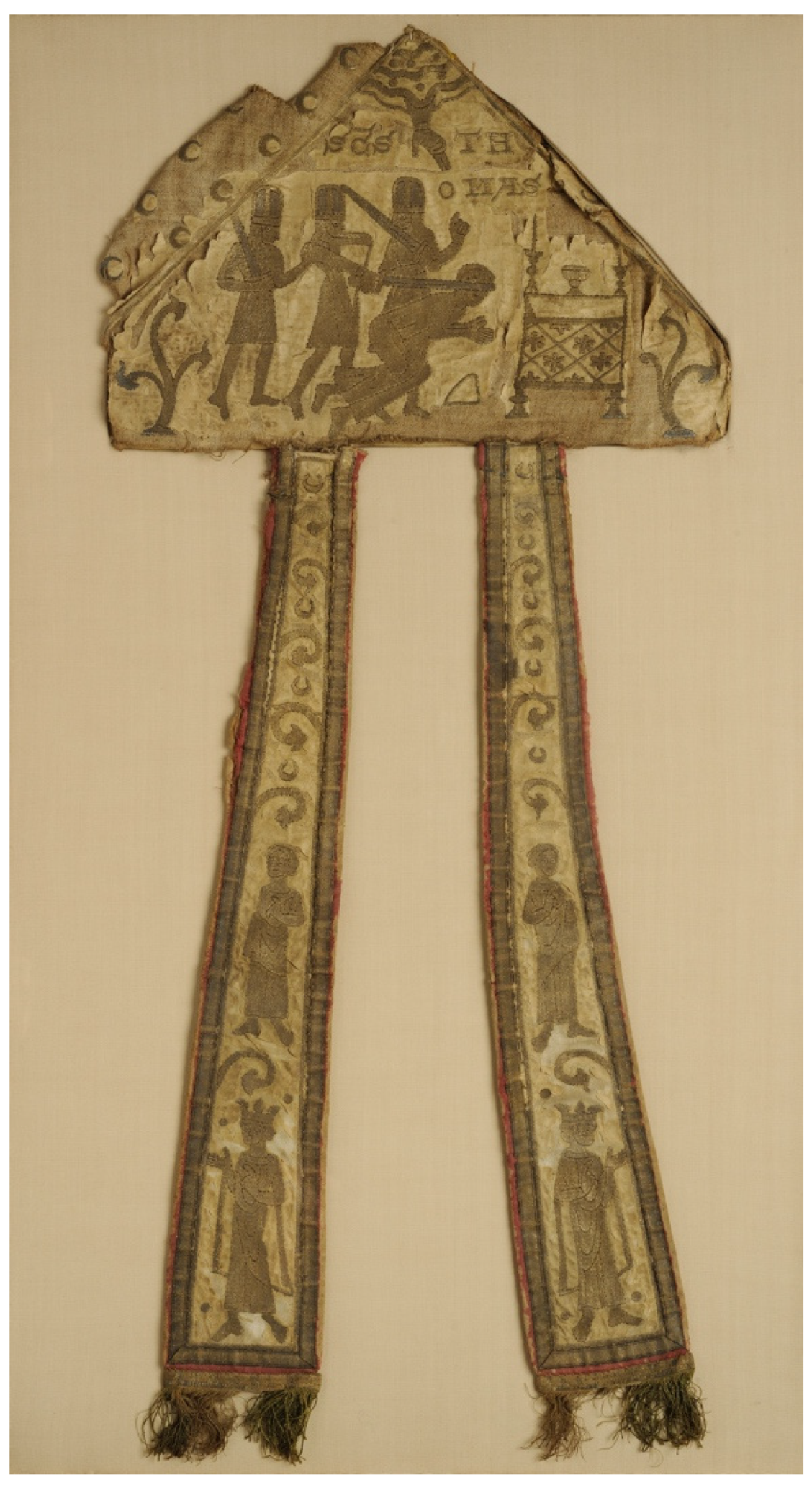
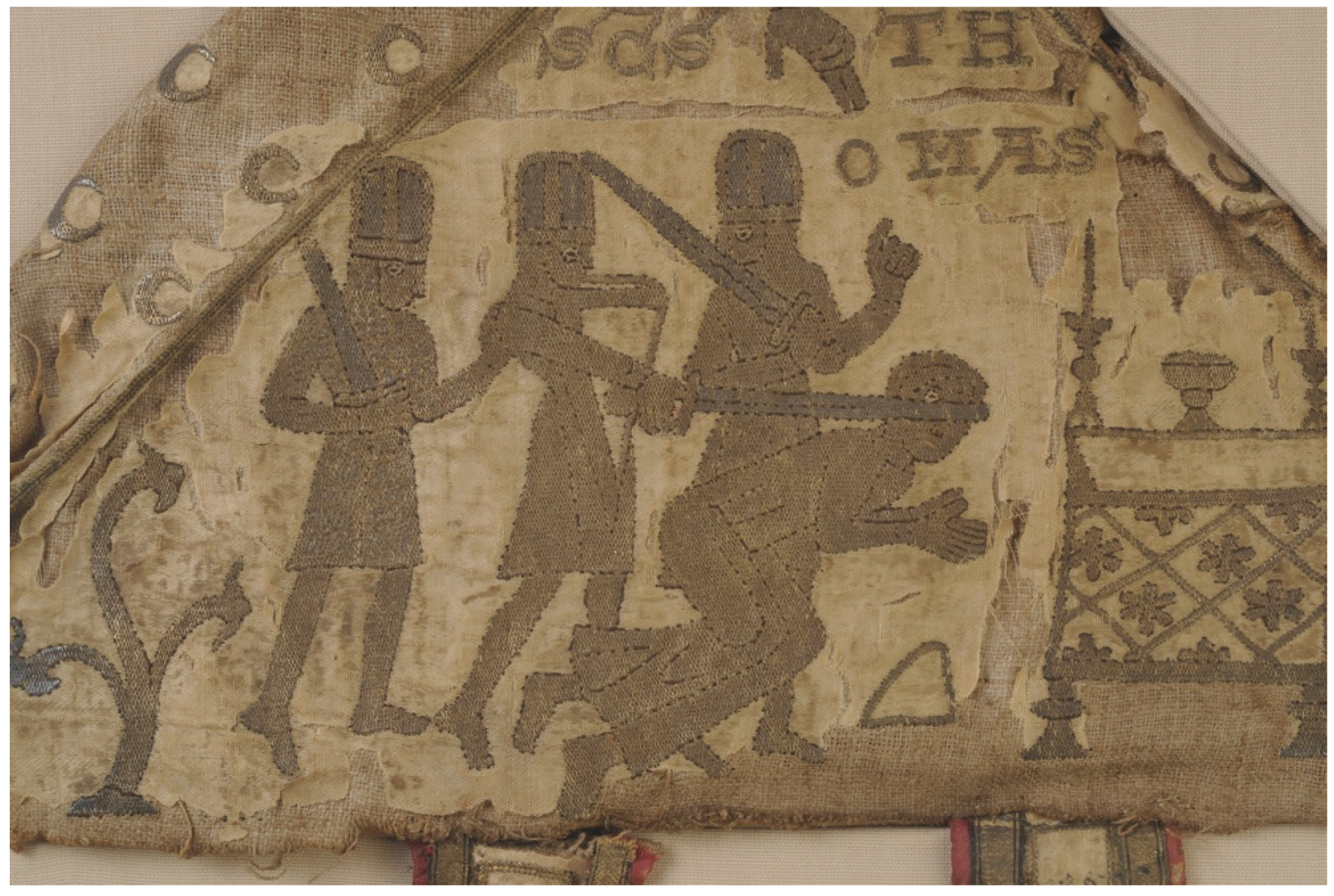
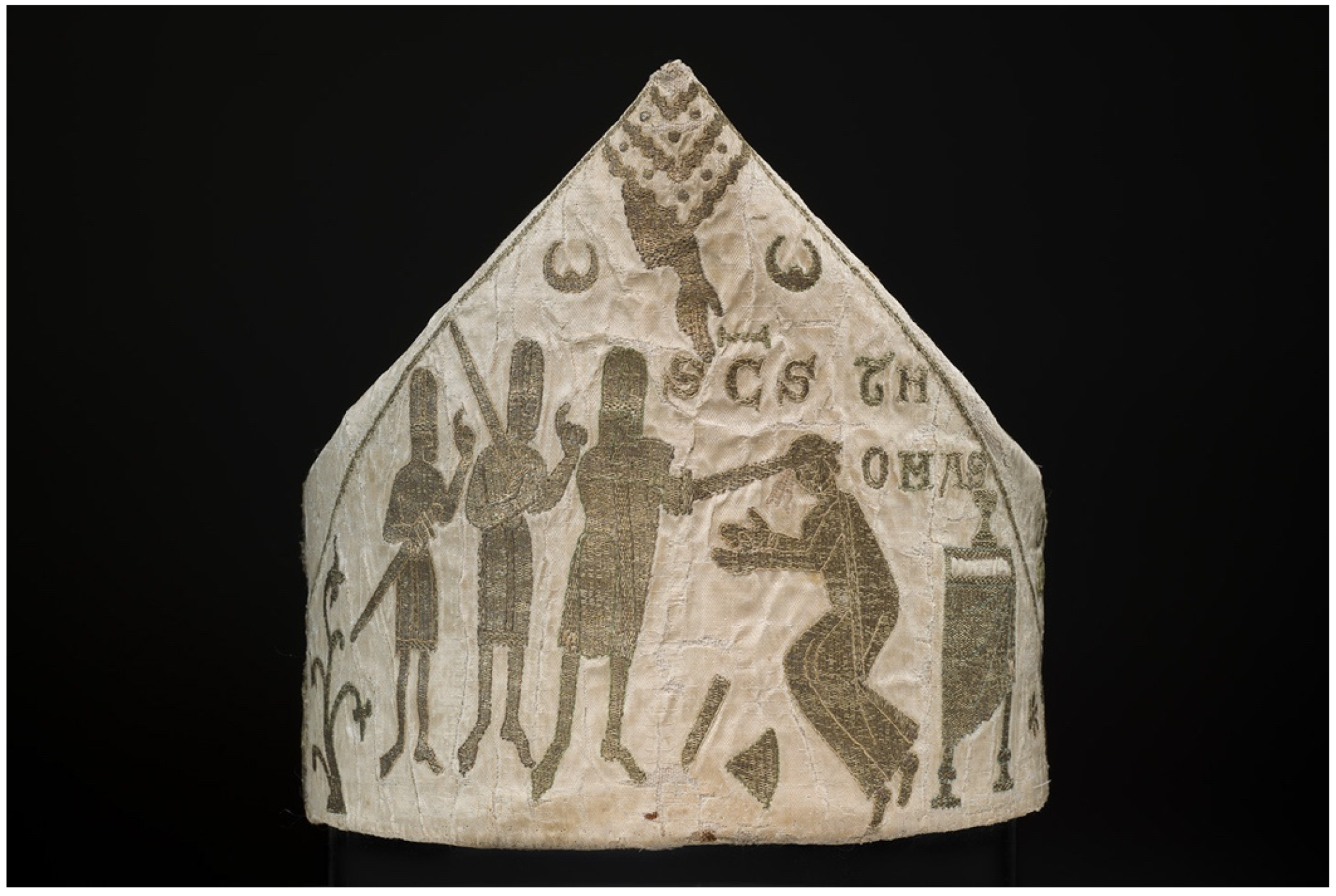
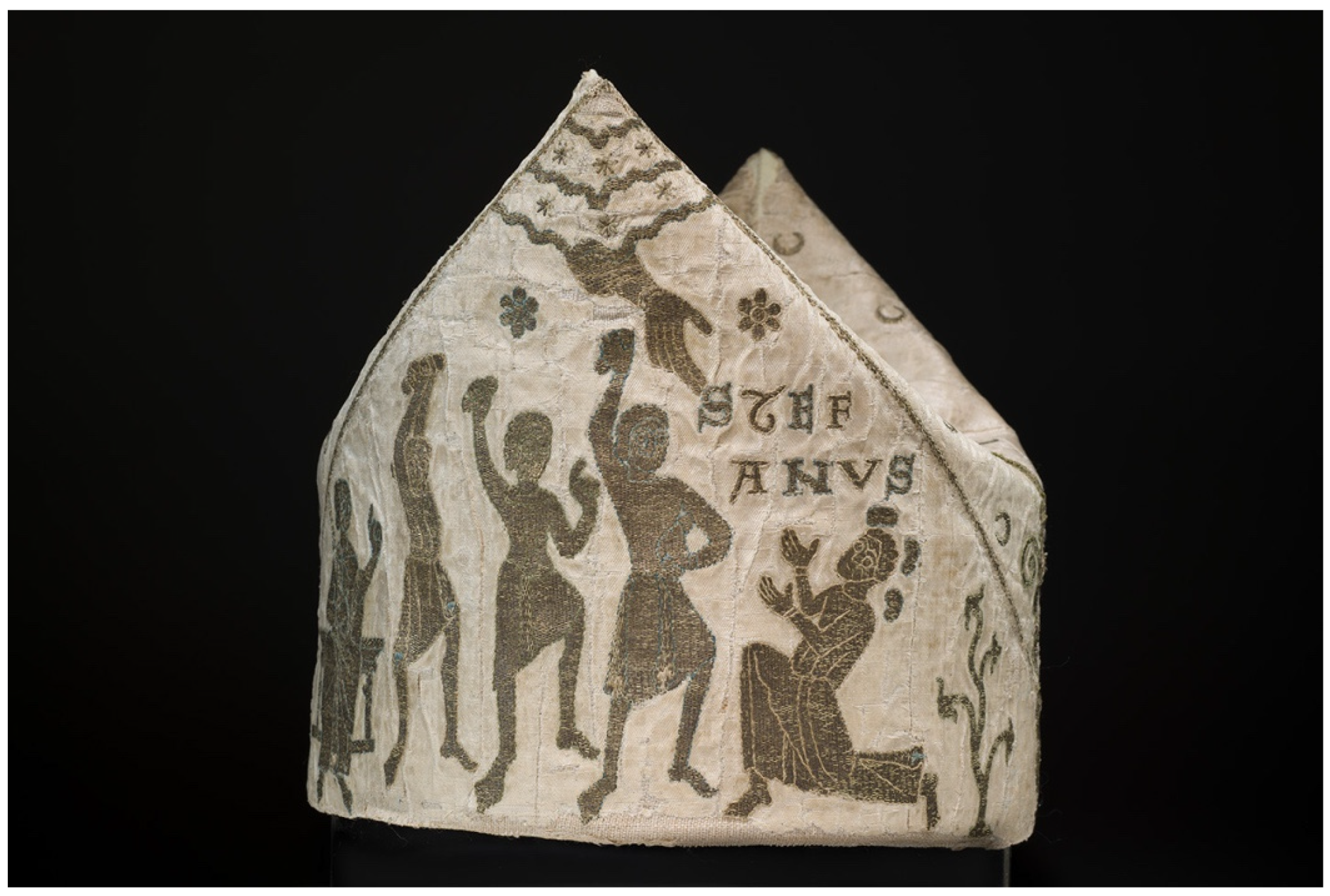
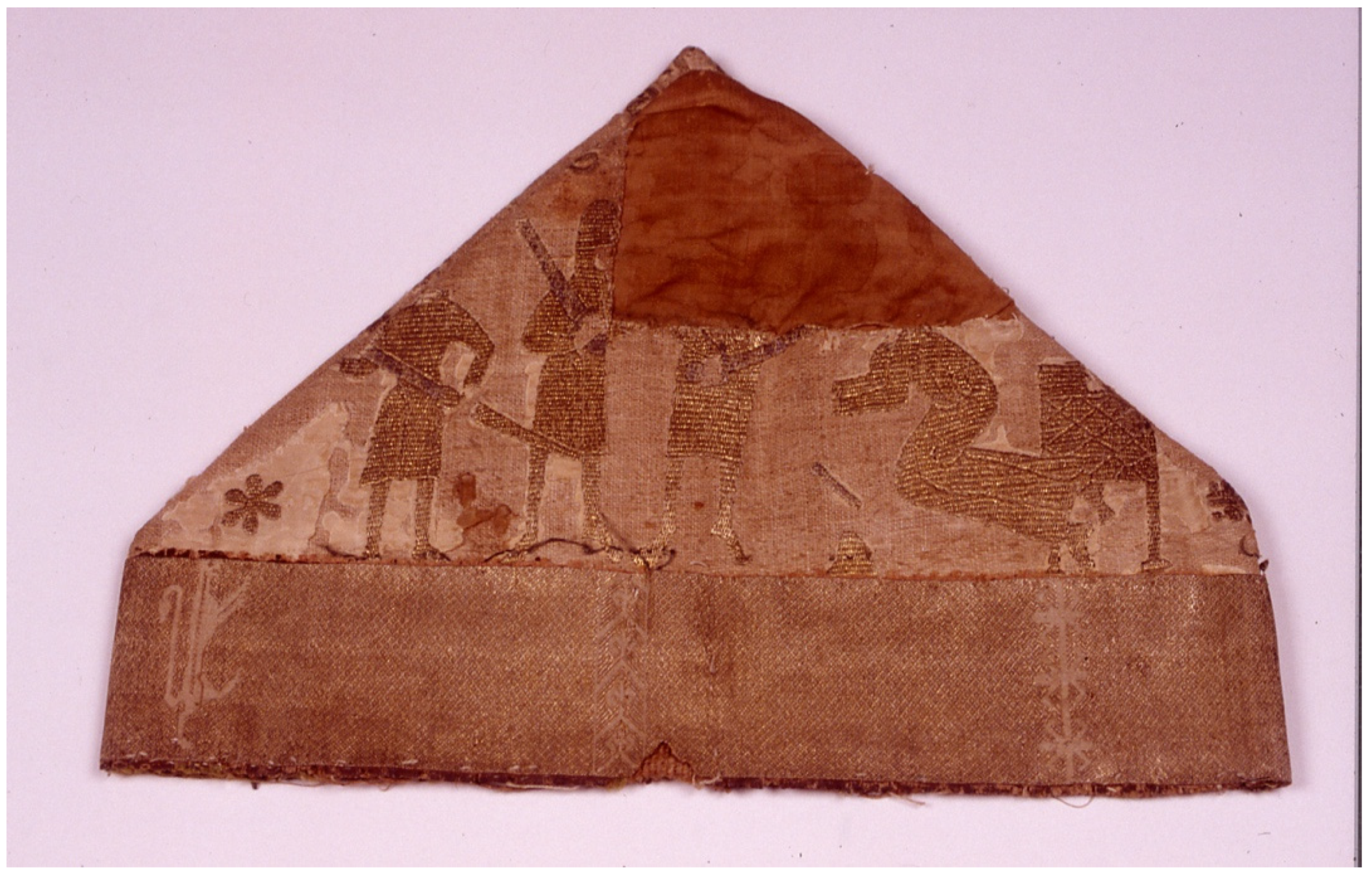
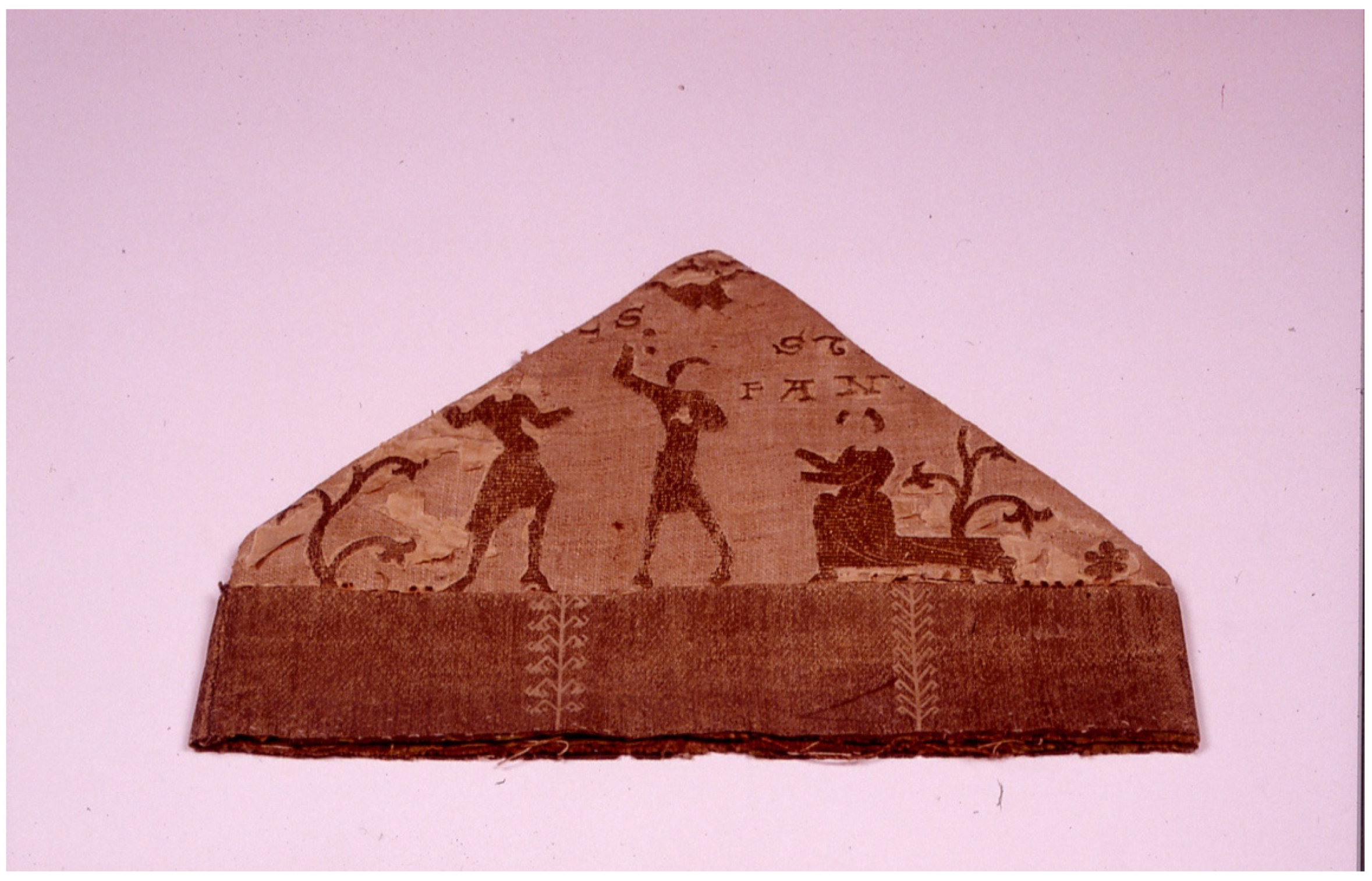
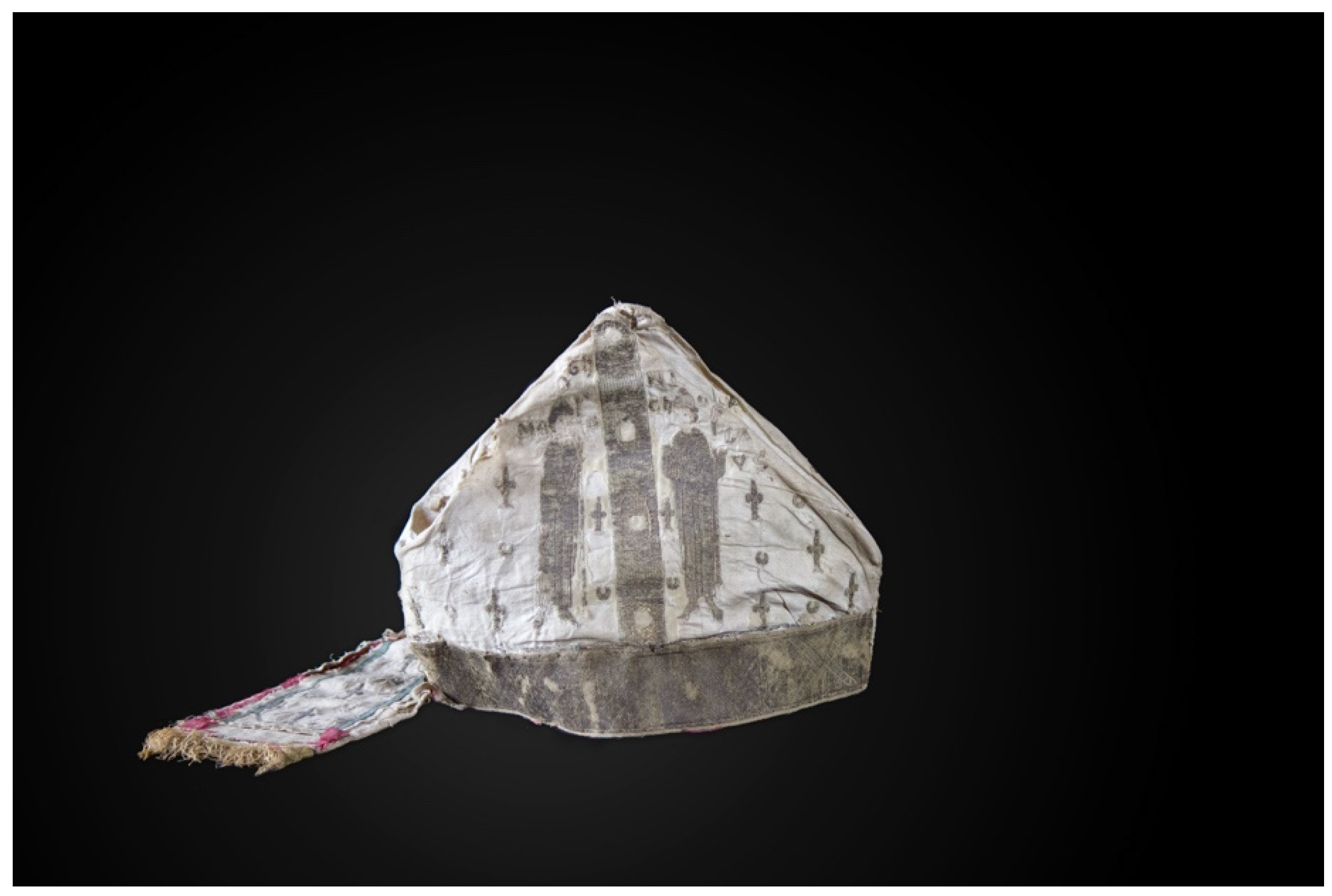
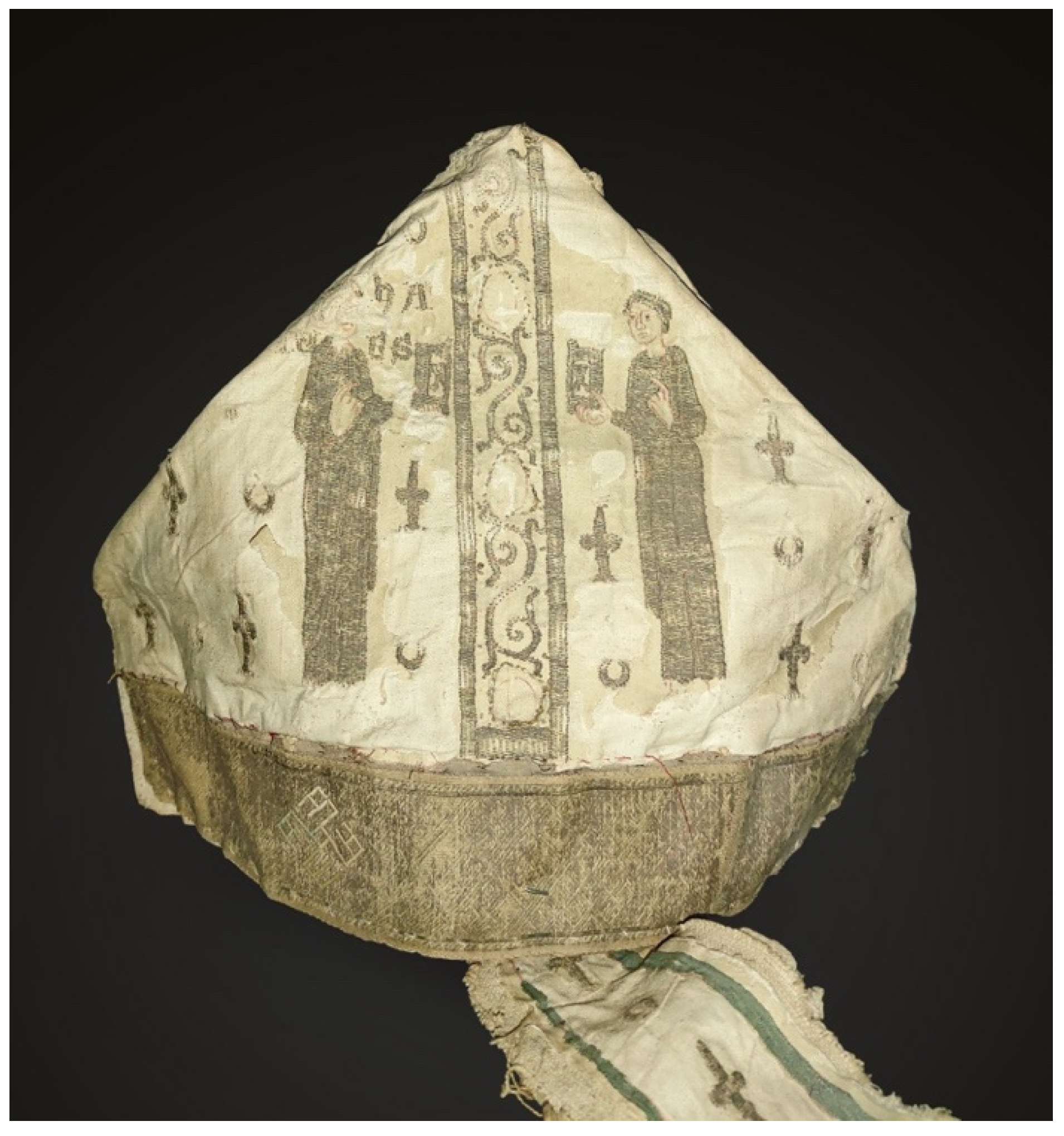

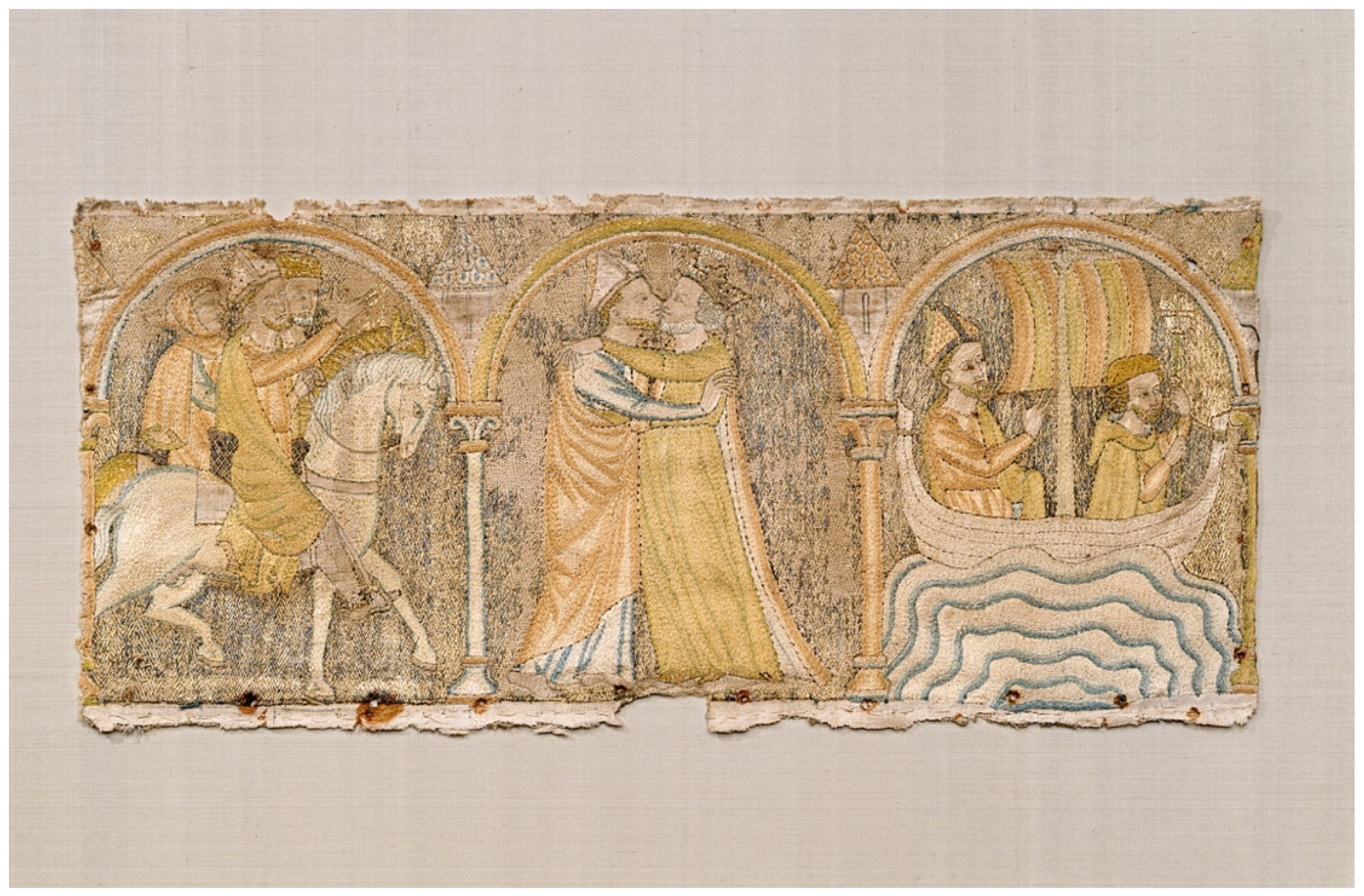
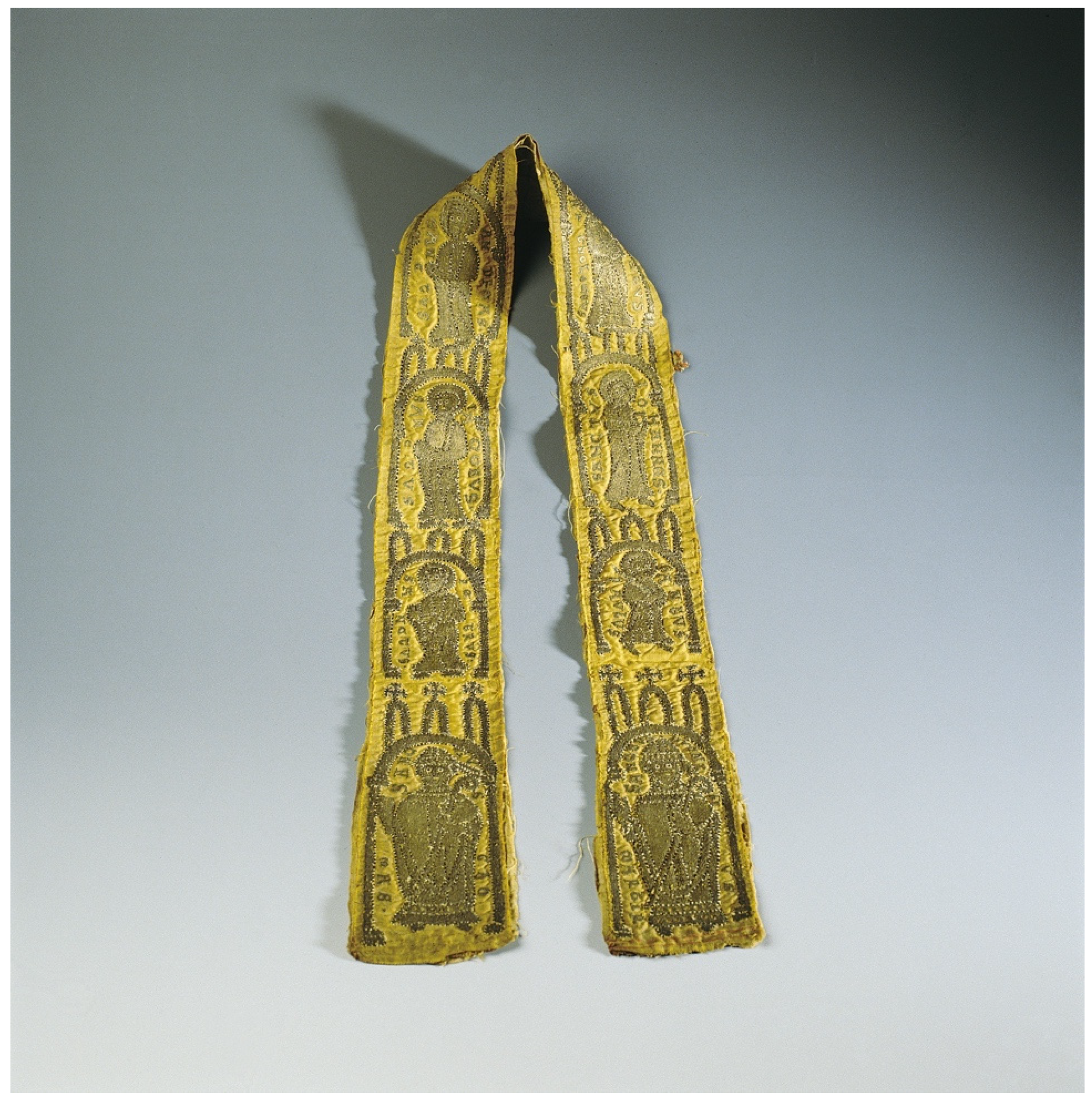
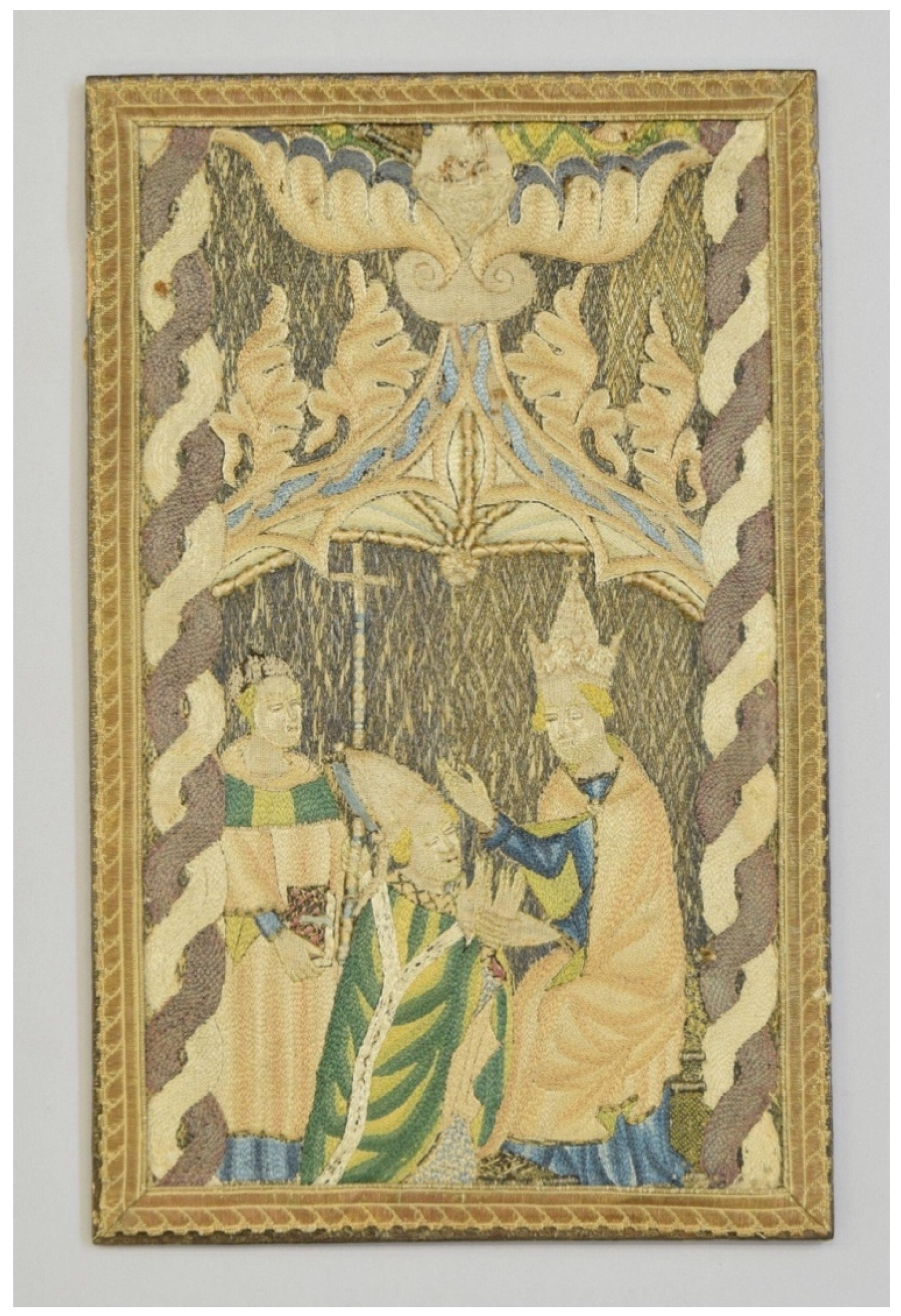
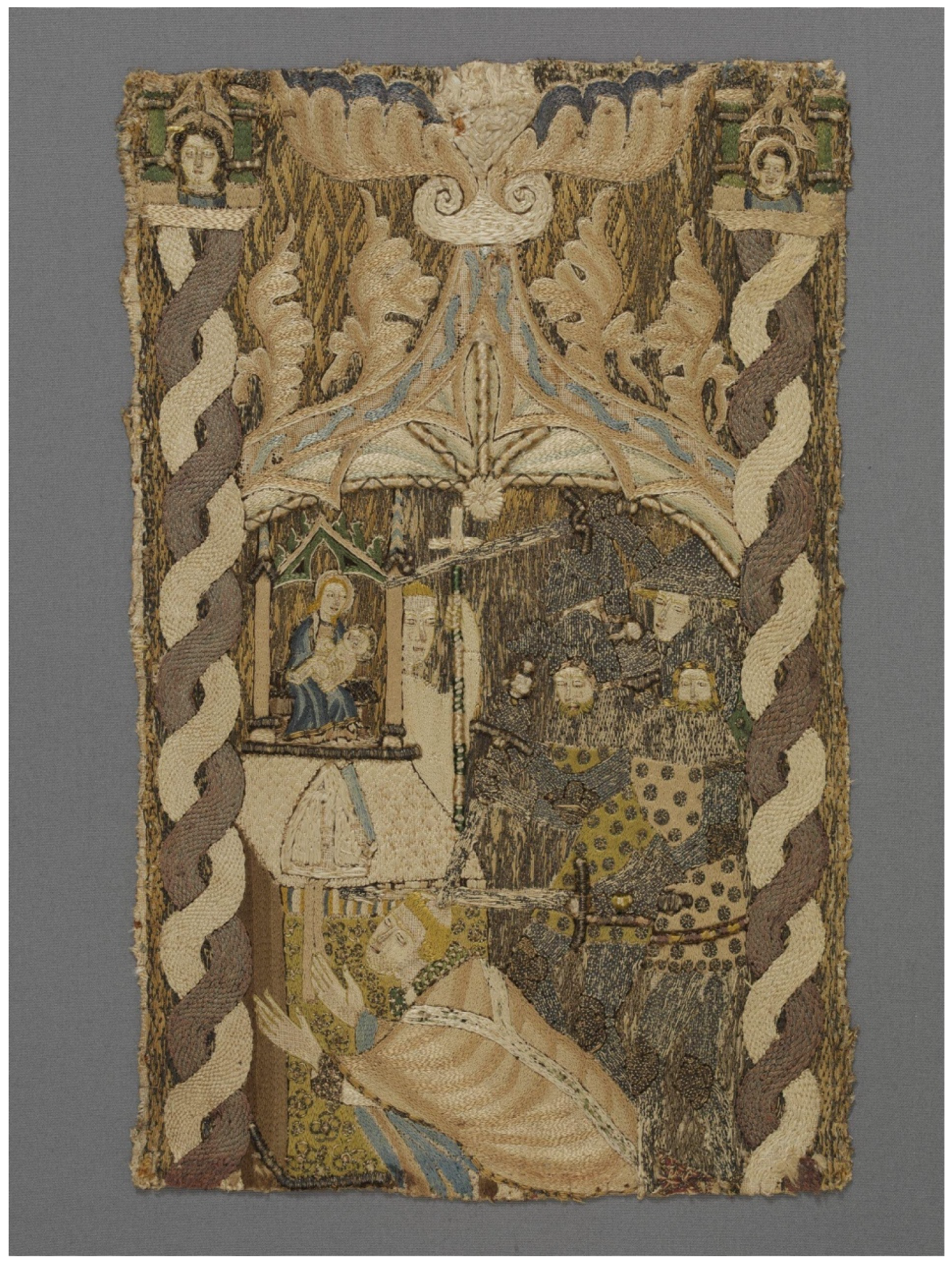
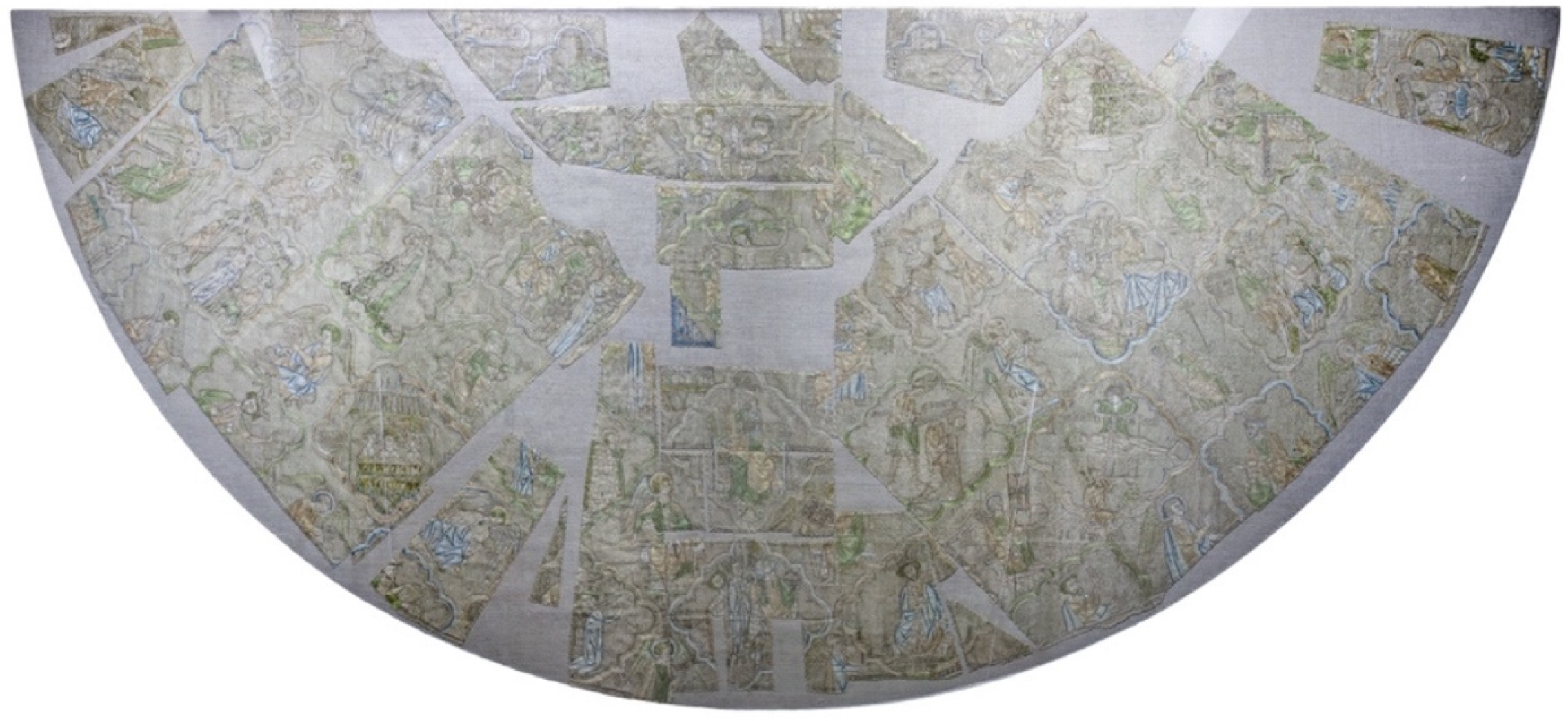
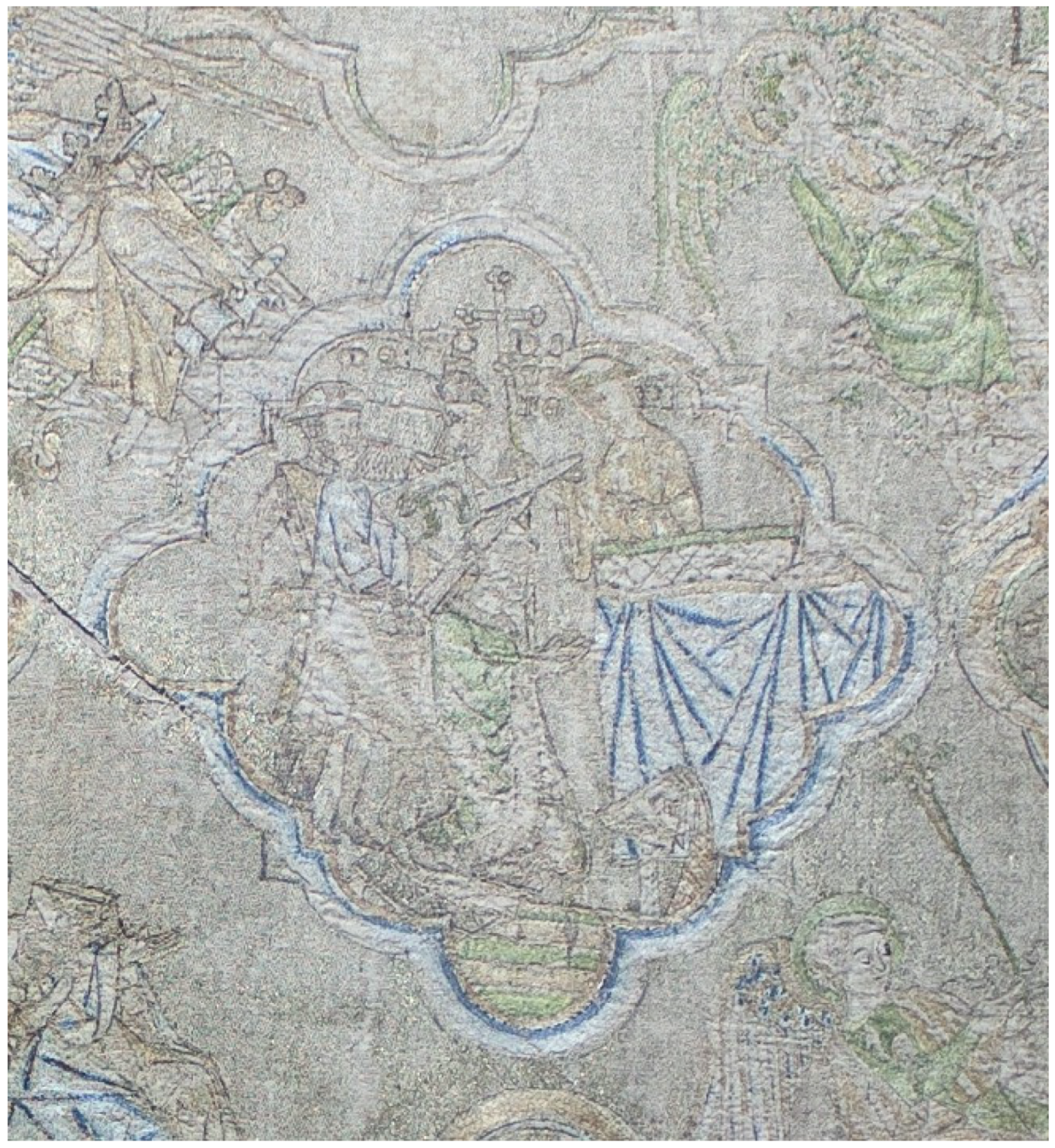
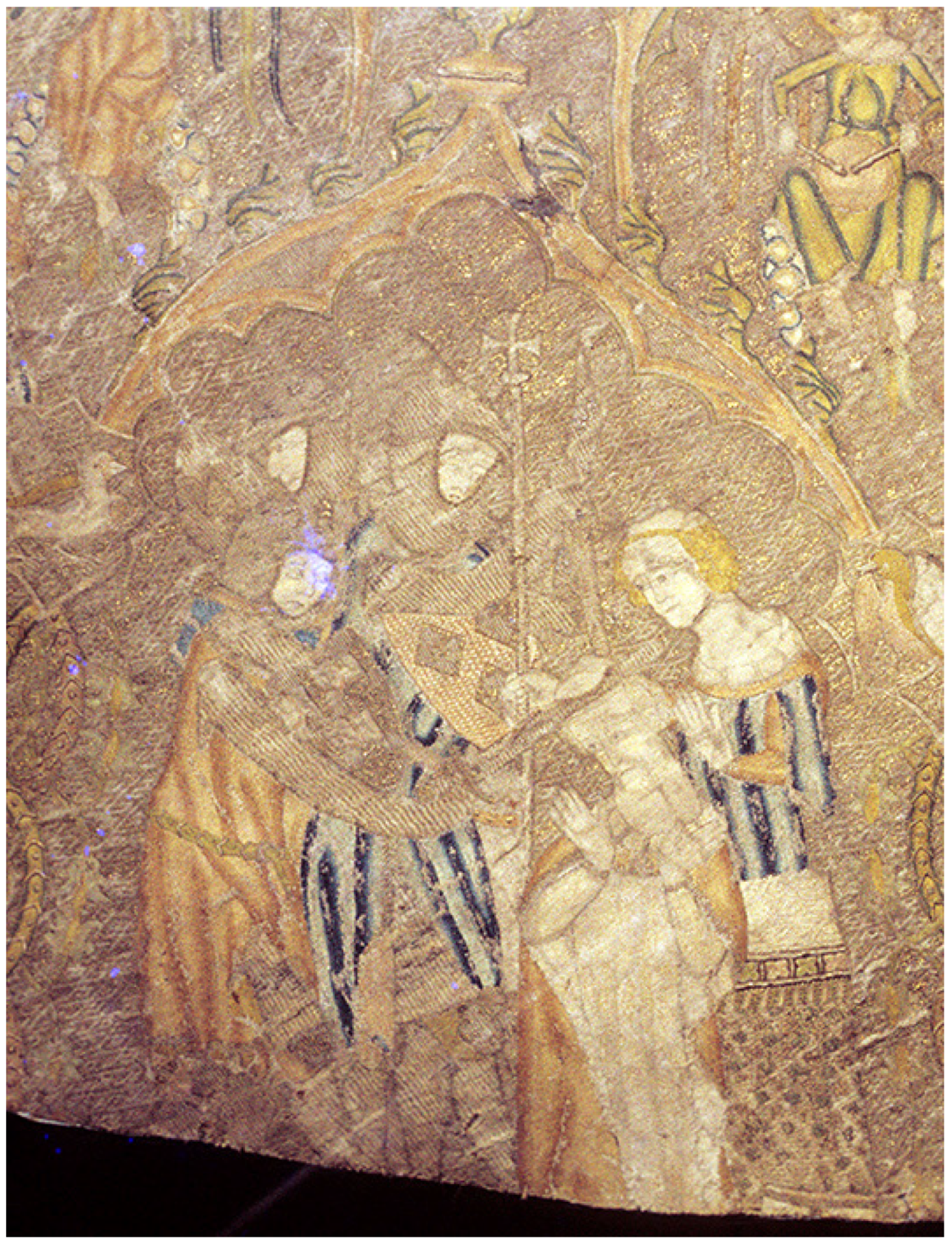
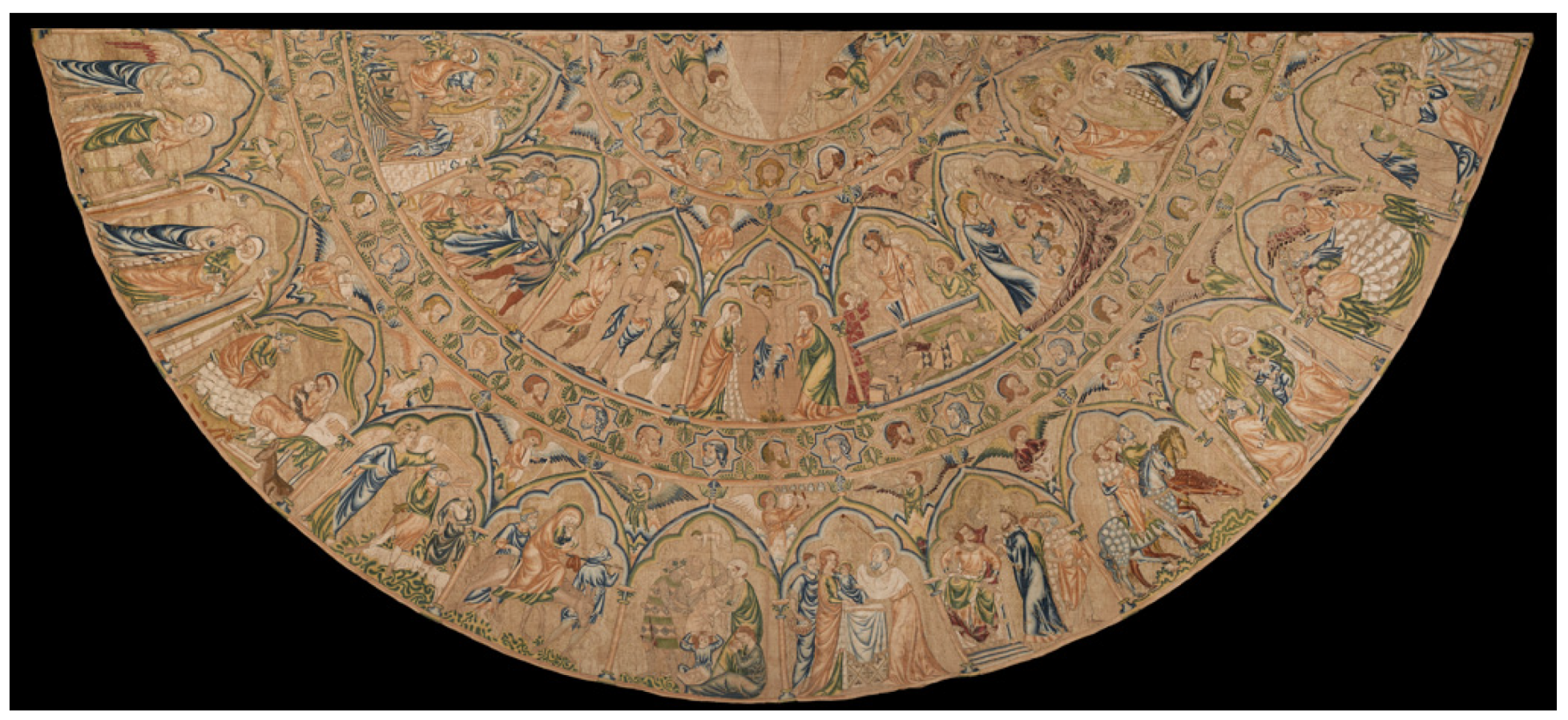


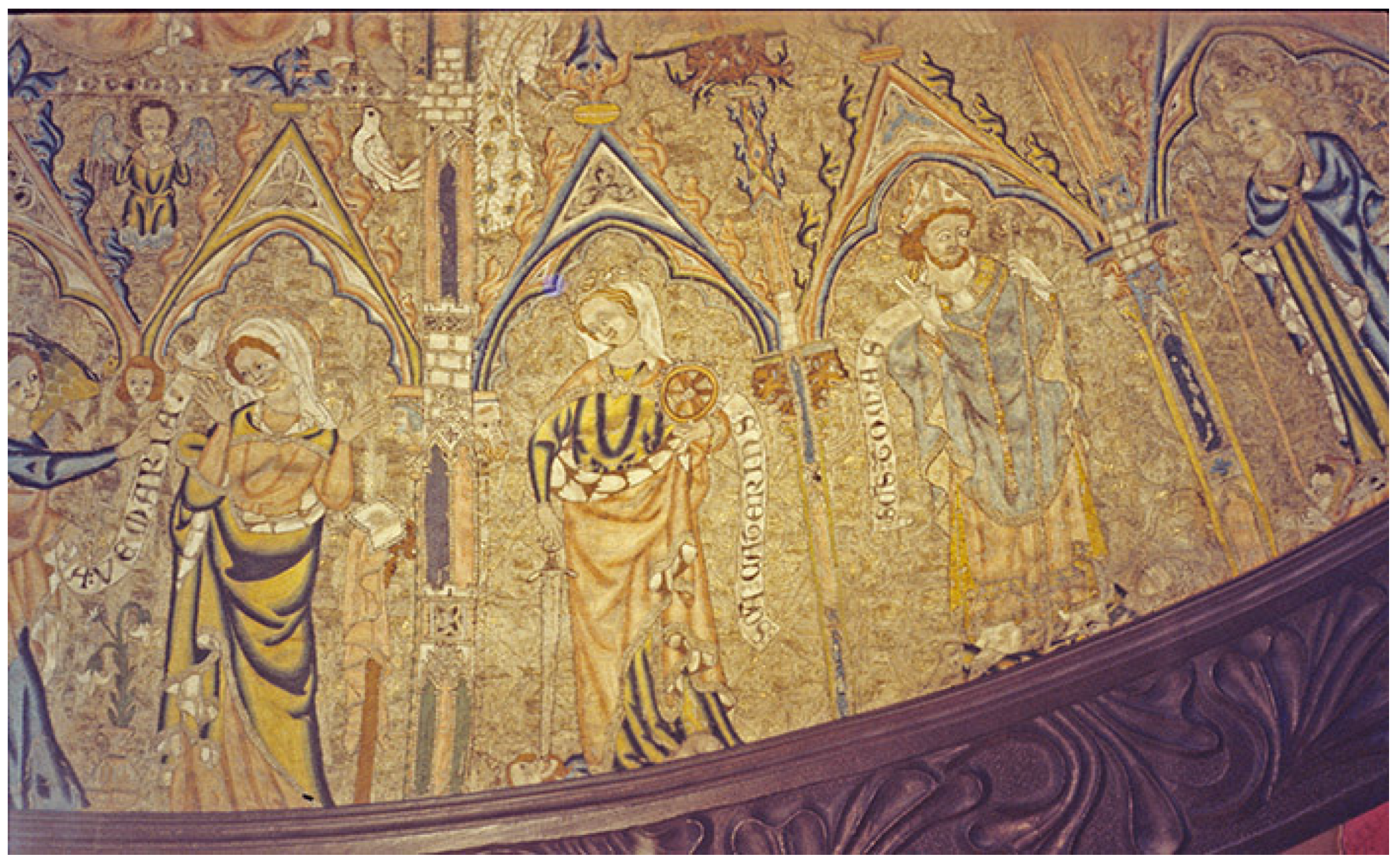
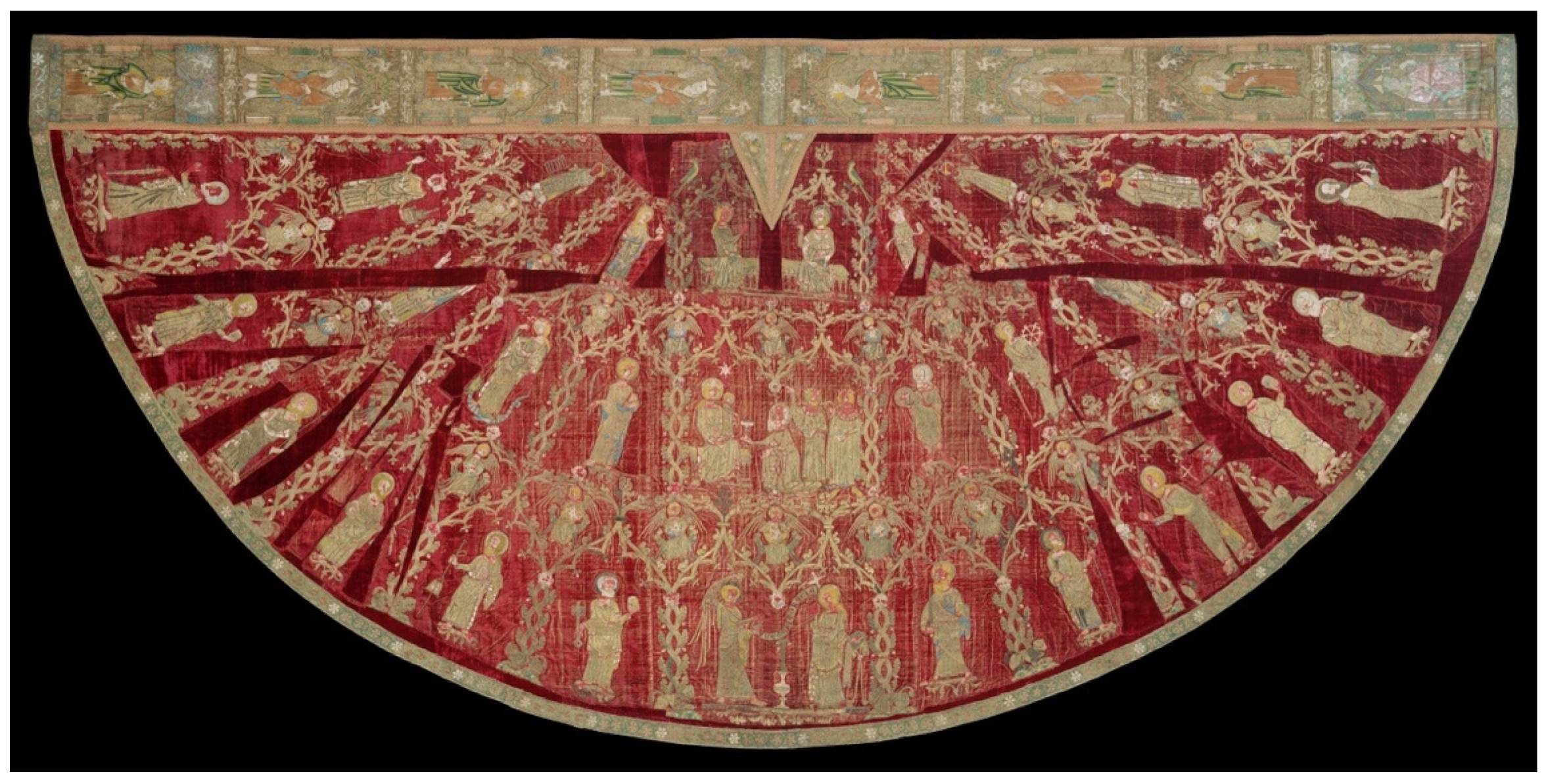
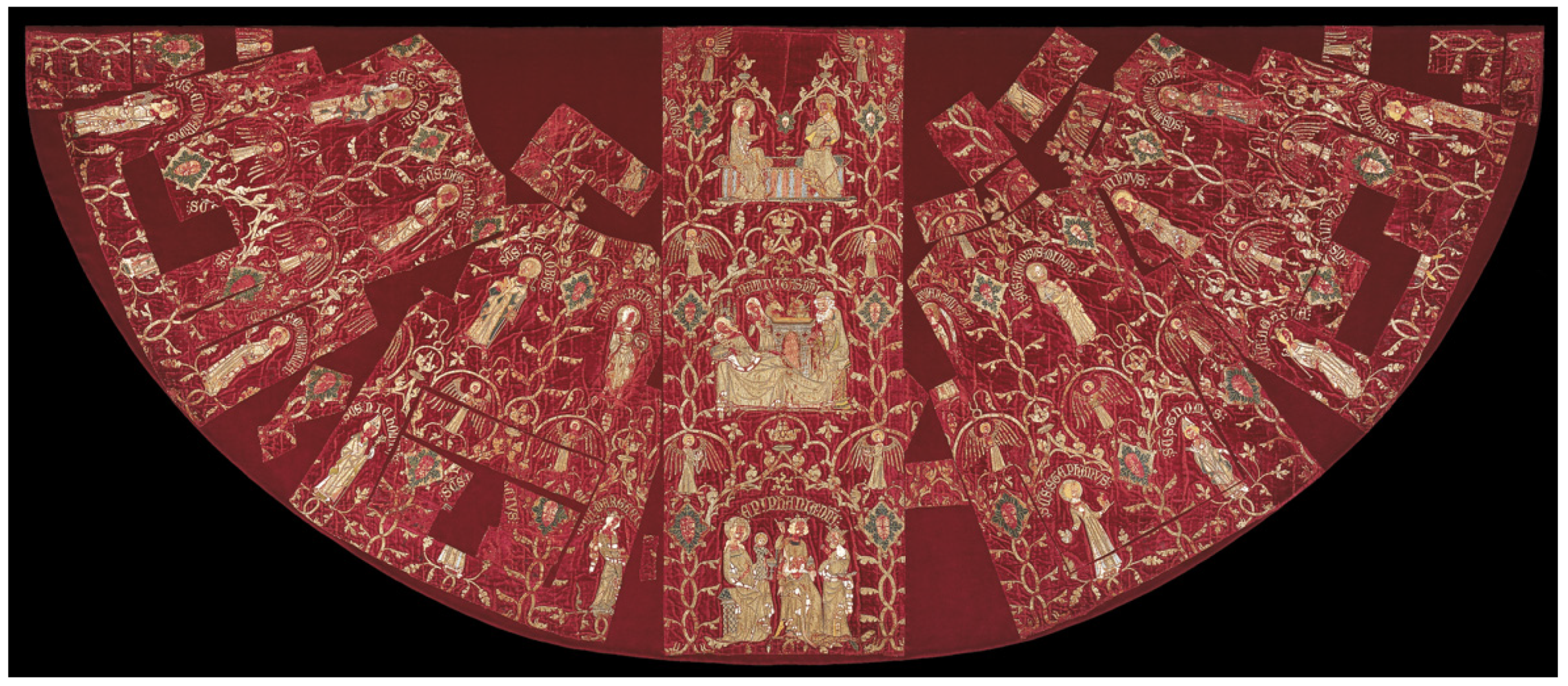

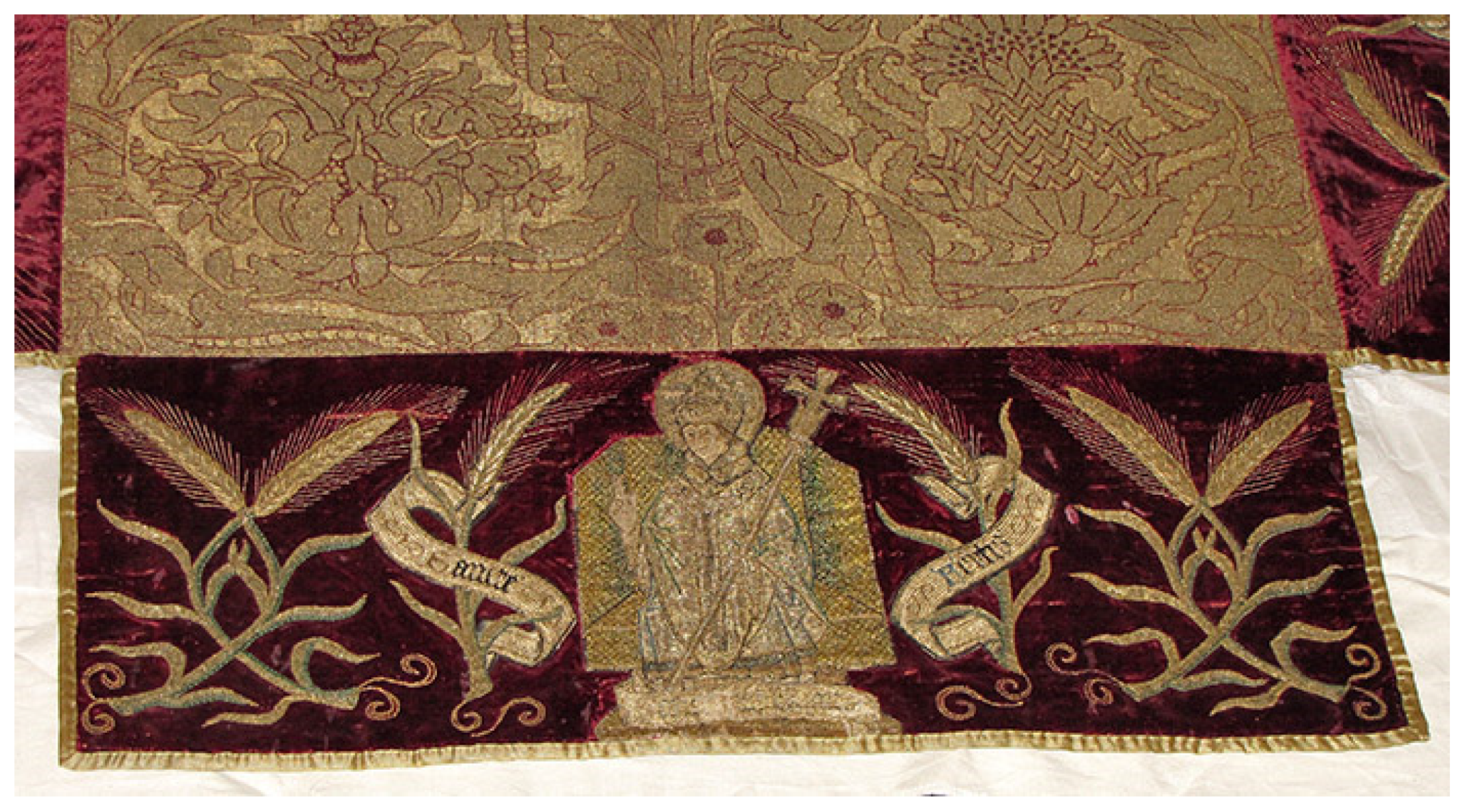
Publisher’s Note: MDPI stays neutral with regard to jurisdictional claims in published maps and institutional affiliations. |
© 2022 by the author. Licensee MDPI, Basel, Switzerland. This article is an open access article distributed under the terms and conditions of the Creative Commons Attribution (CC BY) license (https://creativecommons.org/licenses/by/4.0/).
Share and Cite
Le Luel, N. Embroidering the Life of Thomas Becket during the Middle Ages: Cult and Devotion in Liturgical Vestments. Arts 2022, 11, 73. https://doi.org/10.3390/arts11040073
Le Luel N. Embroidering the Life of Thomas Becket during the Middle Ages: Cult and Devotion in Liturgical Vestments. Arts. 2022; 11(4):73. https://doi.org/10.3390/arts11040073
Chicago/Turabian StyleLe Luel, Nathalie. 2022. "Embroidering the Life of Thomas Becket during the Middle Ages: Cult and Devotion in Liturgical Vestments" Arts 11, no. 4: 73. https://doi.org/10.3390/arts11040073
APA StyleLe Luel, N. (2022). Embroidering the Life of Thomas Becket during the Middle Ages: Cult and Devotion in Liturgical Vestments. Arts, 11(4), 73. https://doi.org/10.3390/arts11040073




